Why you can trust Tom's Hardware
Comparison Products
The PNY CS2150 goes up against the very fastest drives on record. It needs to prove itself against all the drives that have come before it, even though it’s technically positioned as a "budget" drive — or at least a budget PCIe 5.0 drive. It’s not expected to match the faster PCIe 5.0 drives like the Crucial T705, but it should match or beat almost anything else.
This includes the top-tier PCIe 4.0 SSDs like the Samsung 990 Pro, WD Black SN850X, and SK hynix Platinum P41. Below this are Phison E18-based drives that have an eight-channel controller and DRAM, like the Sabrent Rocket 4 Plus-G and PNY XLR8 CS3140. These drives are all a lot to handle in a laptop, more so than the CS2150, but may offer higher capacities and better edge-case performance.
For a more direct comparison we have the DRAM-equipped Crucial T500, probably the closest competitor aside from the Corsair MP700 Elite that uses the same hardware as the CS2150.
There are budget 4.0 drives in the mix as well, such as the Samsung 990 EVO Plus, the Silicon Power US75, and the Inland TN470. That should cover the best SSD controllers in that class whether they're proprietary, Maxio MAP1602-based, or Phison E27T-based. That also covers a range of flash used in this market segment, although it needs to be cautioned that some drives — like the US75 — are liable to swap hardware over time. (The US75 we tested had TLC flash, which newer variants appear to have shifted to QLC NAND.)
Trace Testing — 3DMark Storage Benchmark
Built for gamers, 3DMark’s Storage Benchmark focuses on real-world gaming performance. Each round in this benchmark stresses storage based on gaming activities including loading games, saving progress, installing game files, and recording gameplay video streams. Future gaming benchmarks will be DirectStorage-inclusive and we also include notes about which drives may be future-proofed.
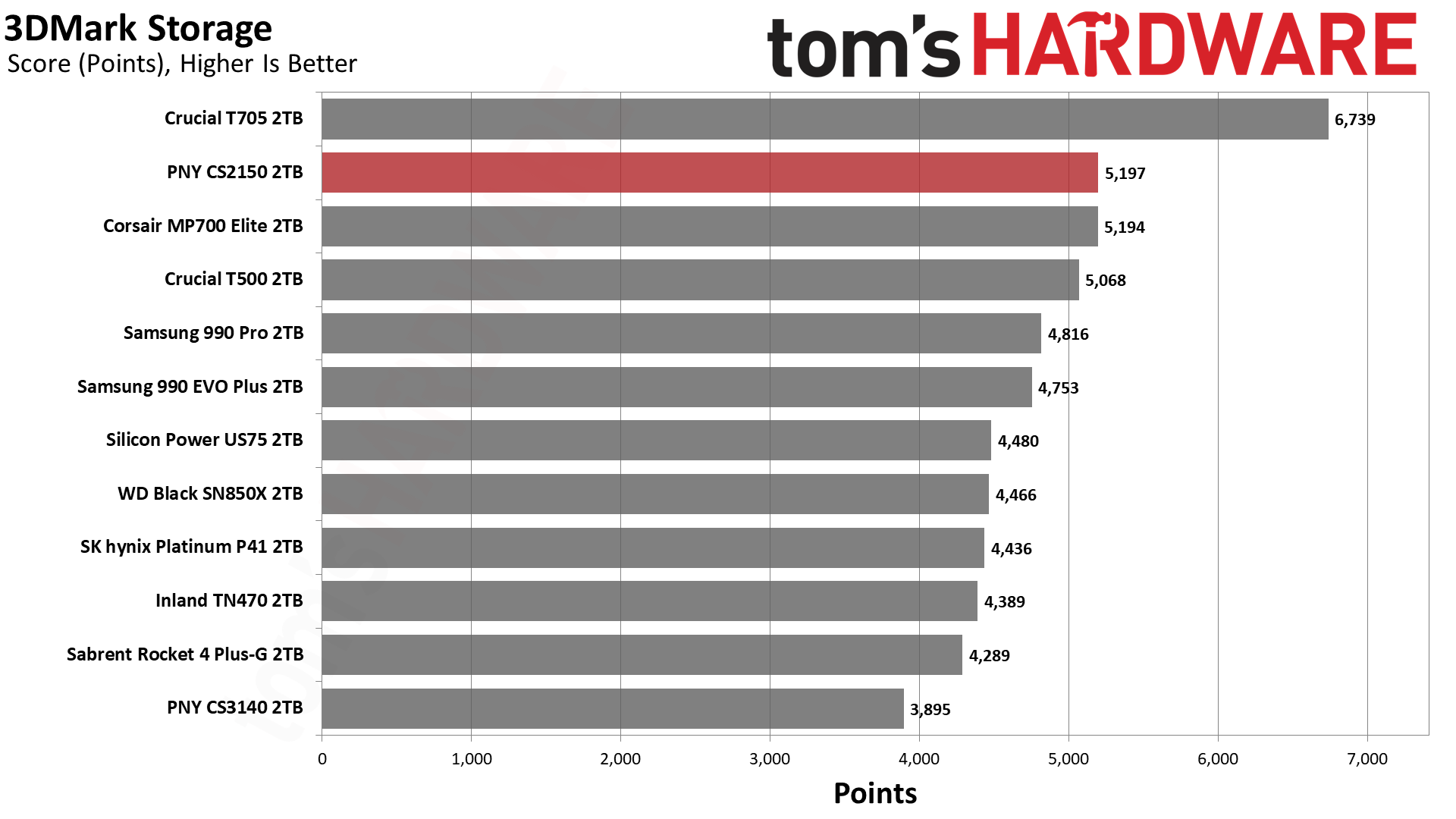
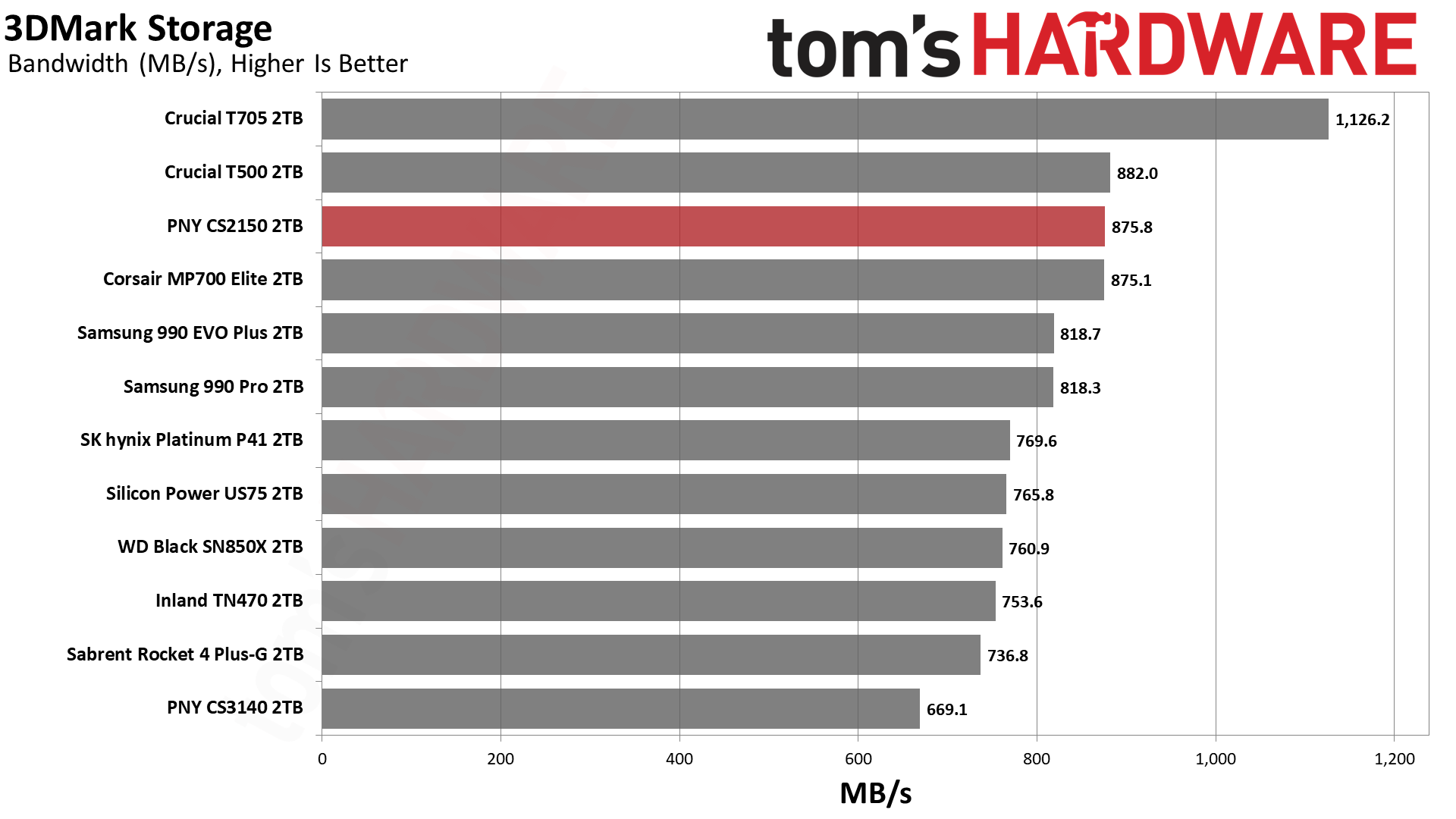
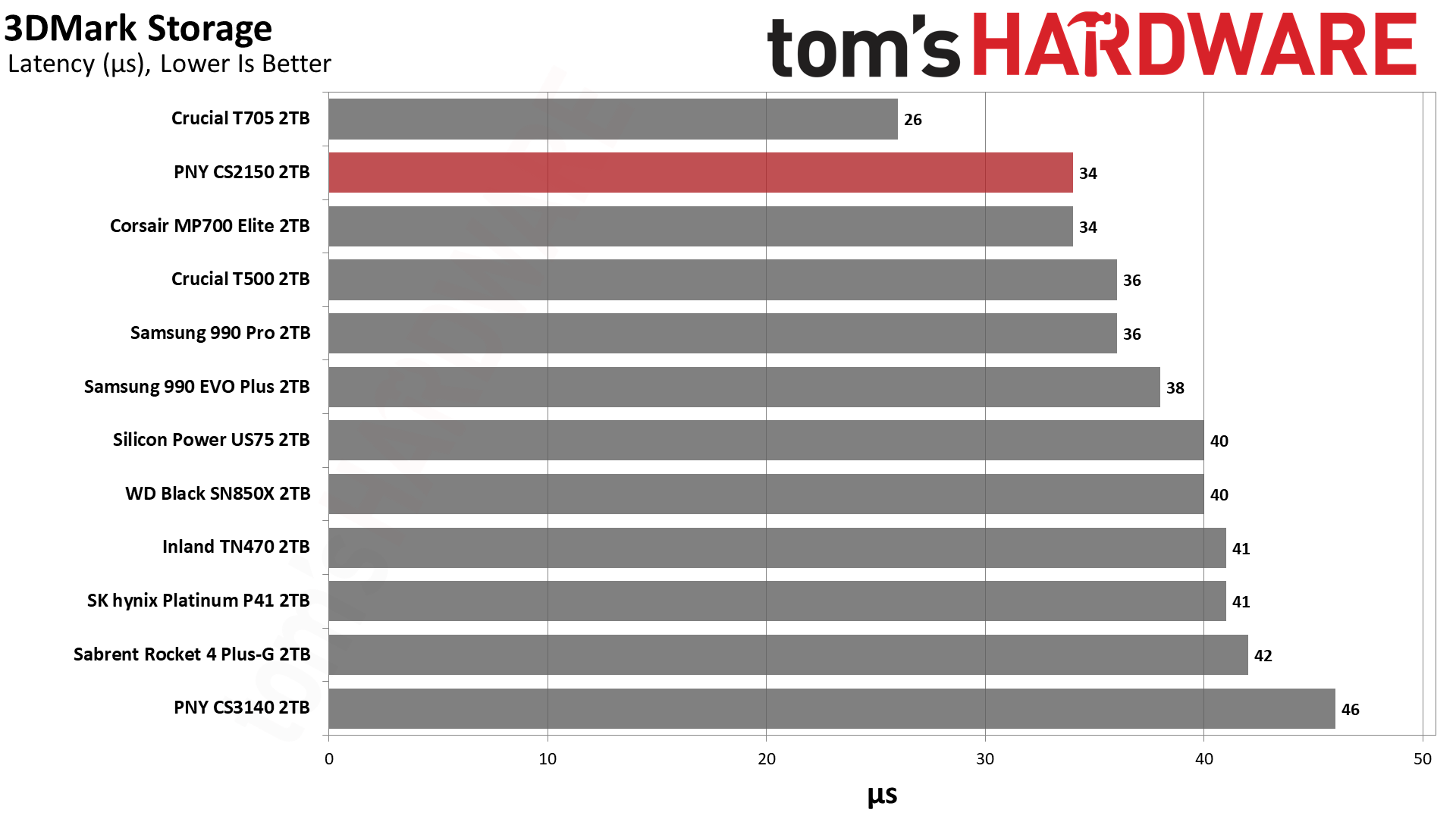
The CS2150 scores very high in our 3DMark Storage Benchmark, matching the MP700 Elite and falling short of only the T705. This would be an excellent game drive even when compared to the very best of the previous generation. Phison also promises optimizations for DirectStorage when it becomes relevant.
Trace Testing — PCMark 10 Storage Benchmark
PCMark 10 is a trace-based benchmark that uses a wide-ranging set of real-world traces from popular applications and everyday tasks to measure the performance of storage devices. The results are particularly useful when analyzing drives for their use as primary/boot storage devices and in work environments.
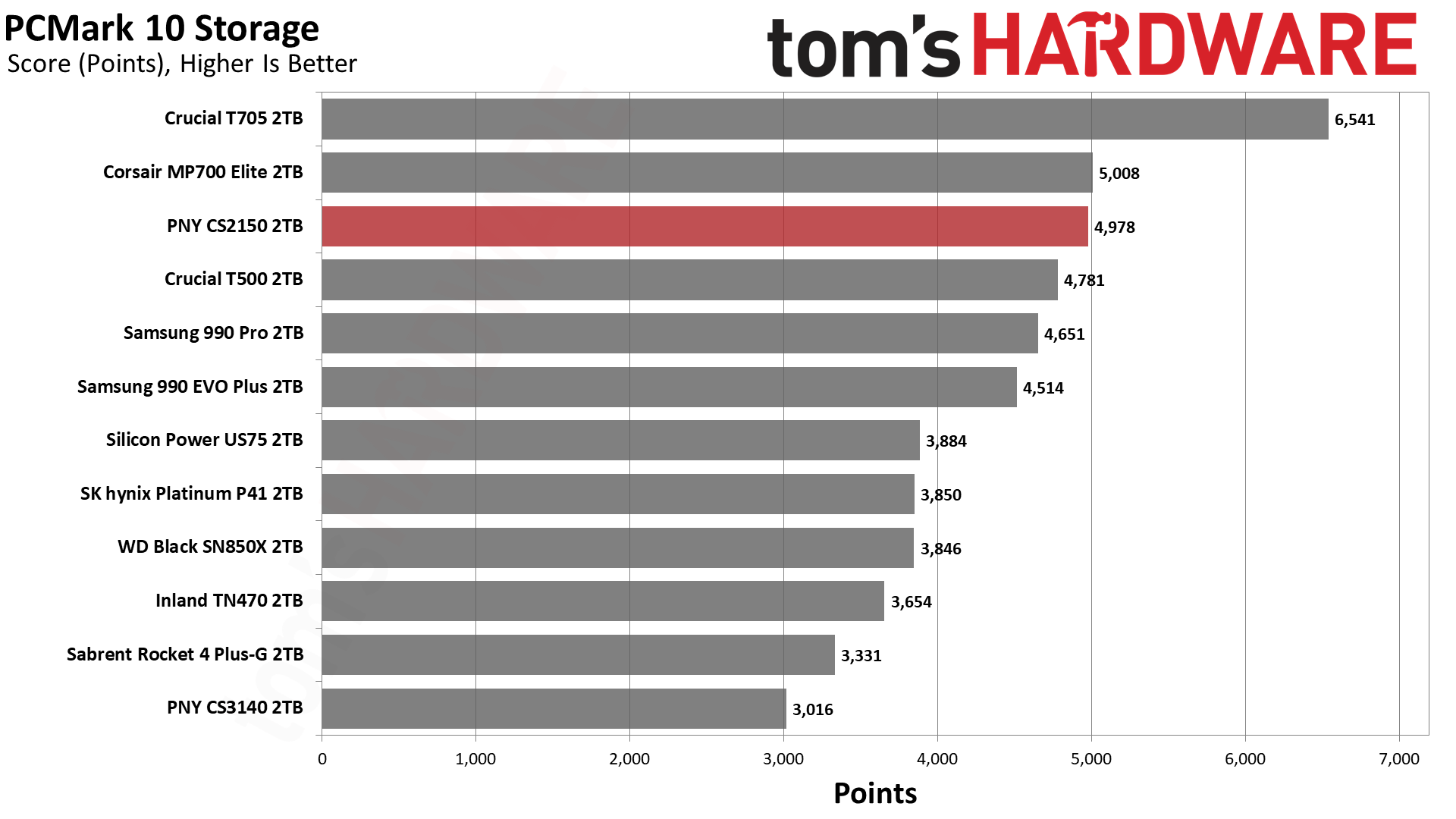
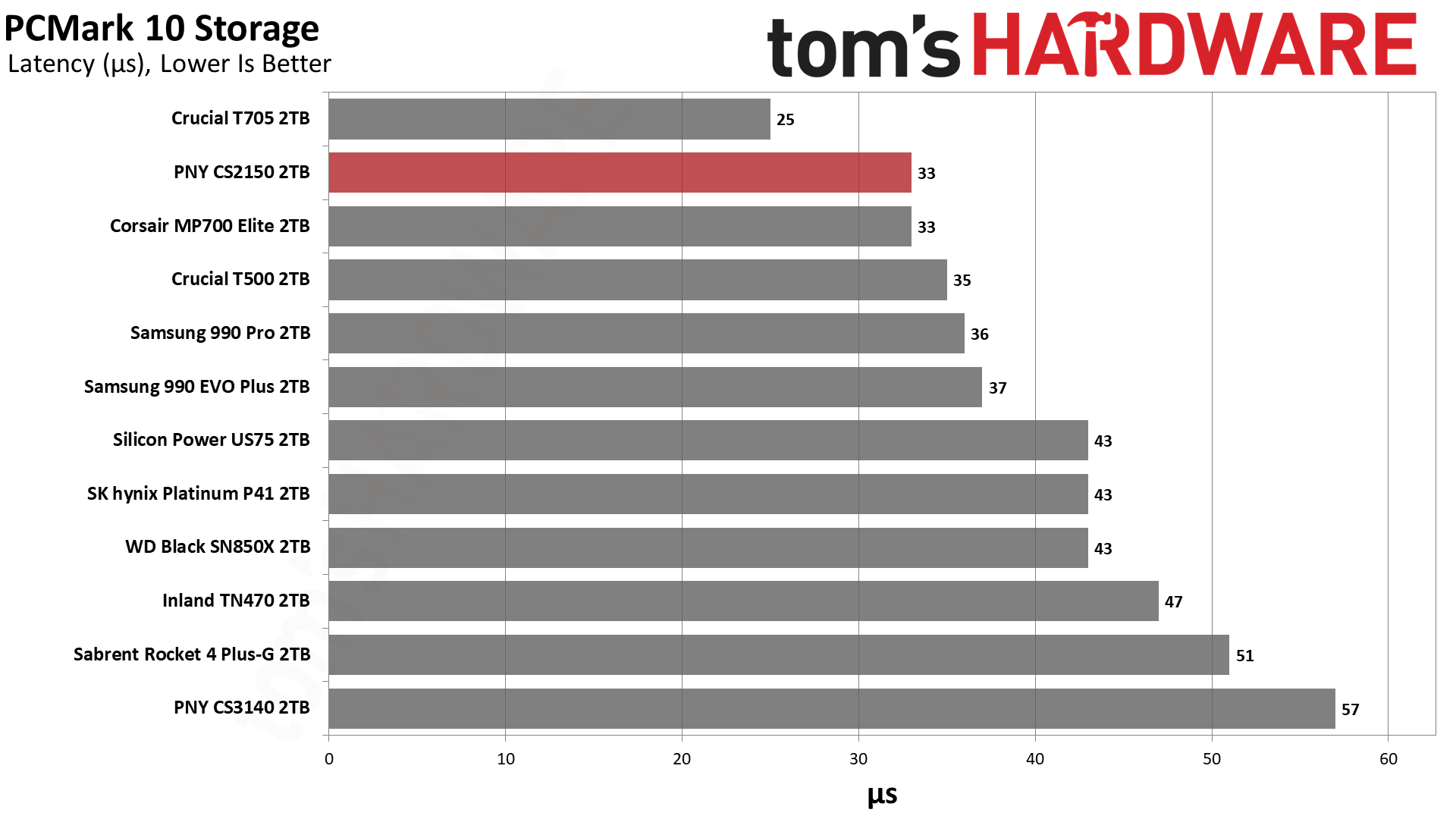
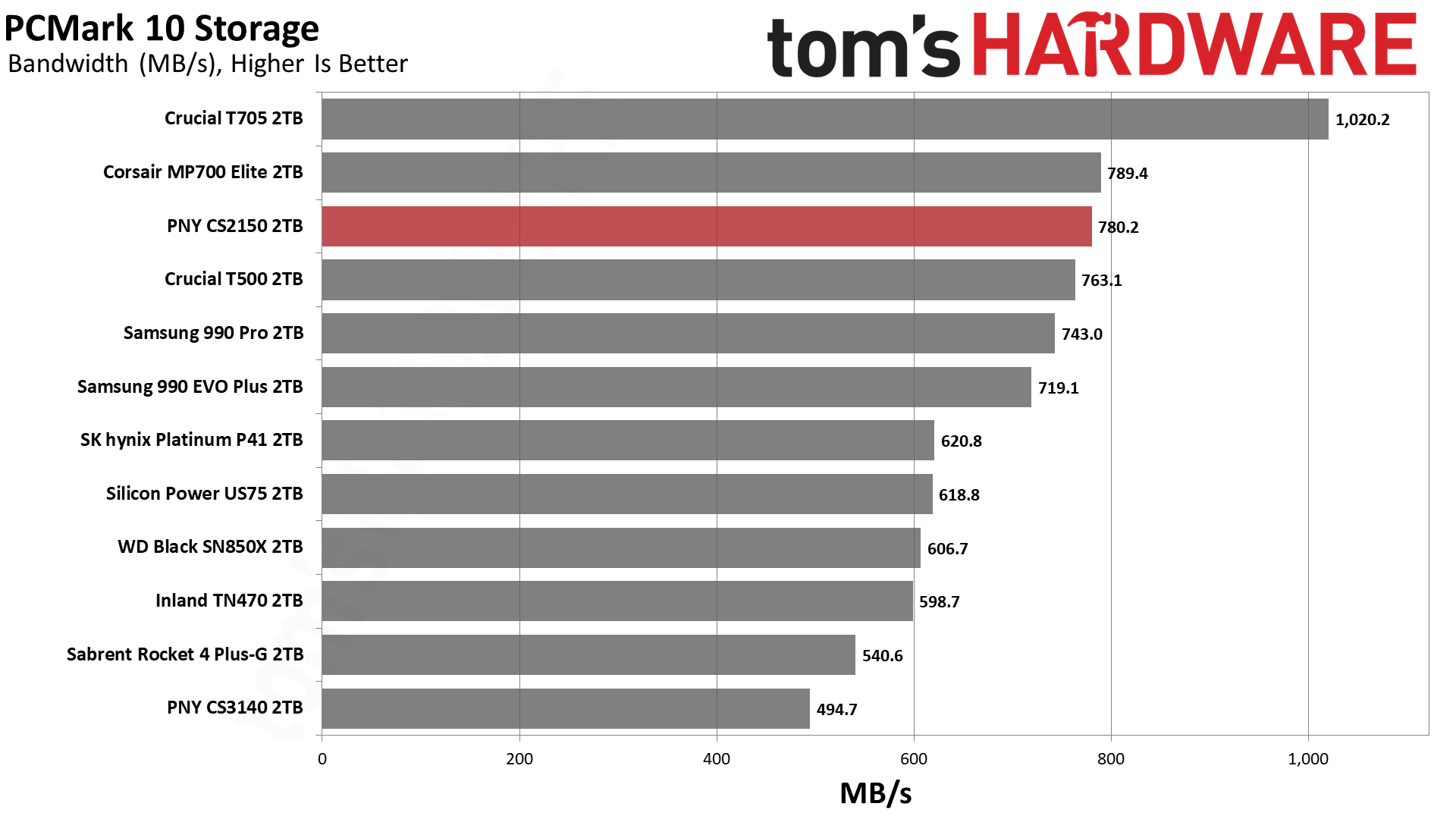
The CS2150 also scores high in PCMark 10, implying excellent desktop and application performance. This is a snappy drive that has few peers that can beat it, and those that do exist — like the T705 — are generally more expensive and much less power-efficient. The CS2150 is a good middle ground if you have a PCIe 5.0 capable system, though the drive would also work well in a 4.0 system if you intend to carry the drive forward or want something ultra-efficient today.
Console Testing — PlayStation 5 Transfers
The PlayStation 5 is capable of taking one additional PCIe 4.0 or faster SSD for extra game storage. While any 4.0 drive will technically work, Sony recommends drives that can deliver at least 5,500 MB/s of sequential read bandwidth for optimal performance. In our testing, PCIe 5.0 SSDs don’t bring much to the table and generally shouldn’t be used in the PS5, especially as they may require additional cooling. Check our Best PS5 SSDs article for more information.
Our testing utilizes the PS5’s internal storage test and manual read/write tests with over 192GB of data both from and to the internal storage. Throttling is prevented where possible to see how each drive operates under ideal conditions. While game load times should not deviate much from drive to drive, our results can indicate which drives may be more responsive in long-term use.
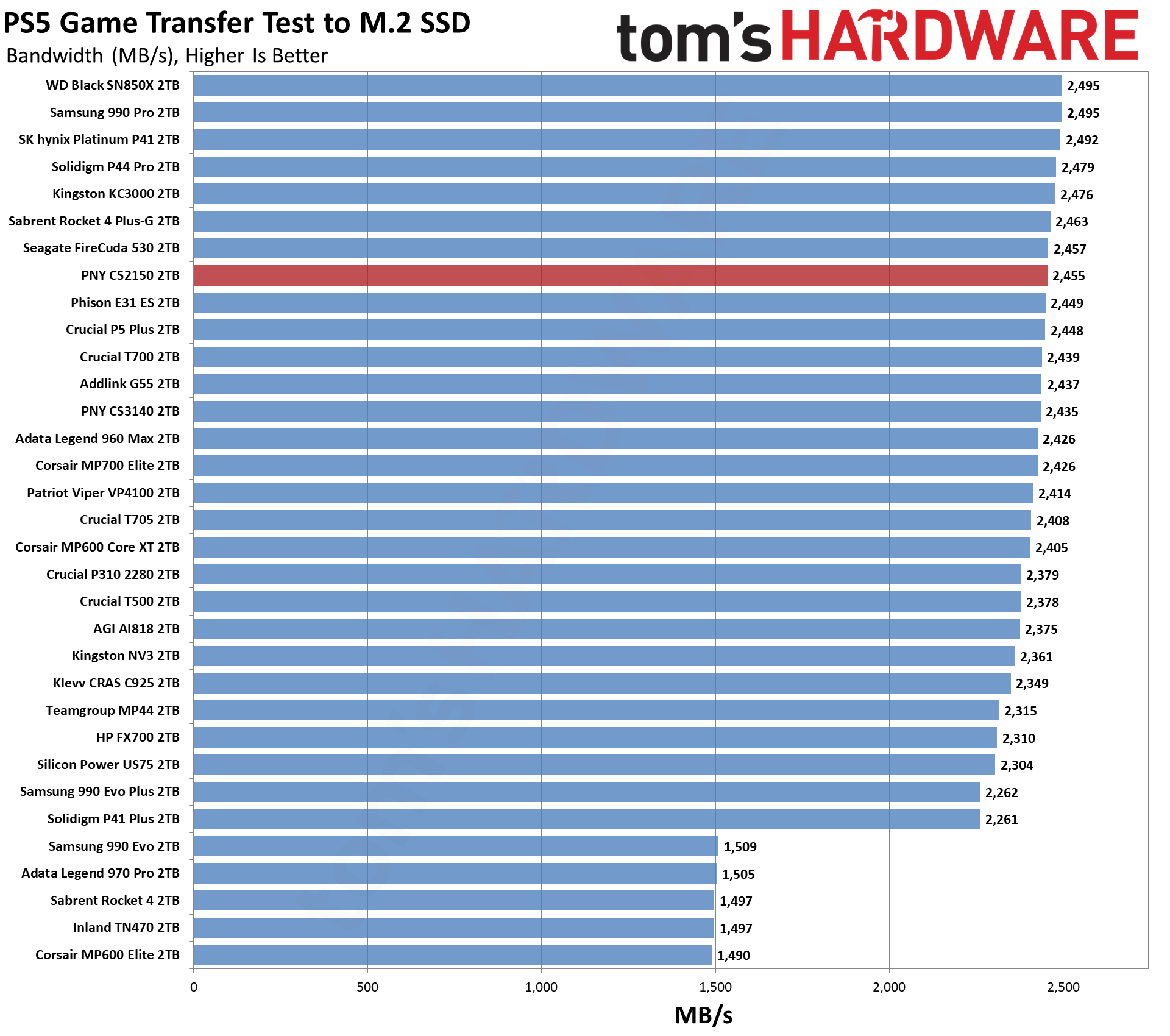
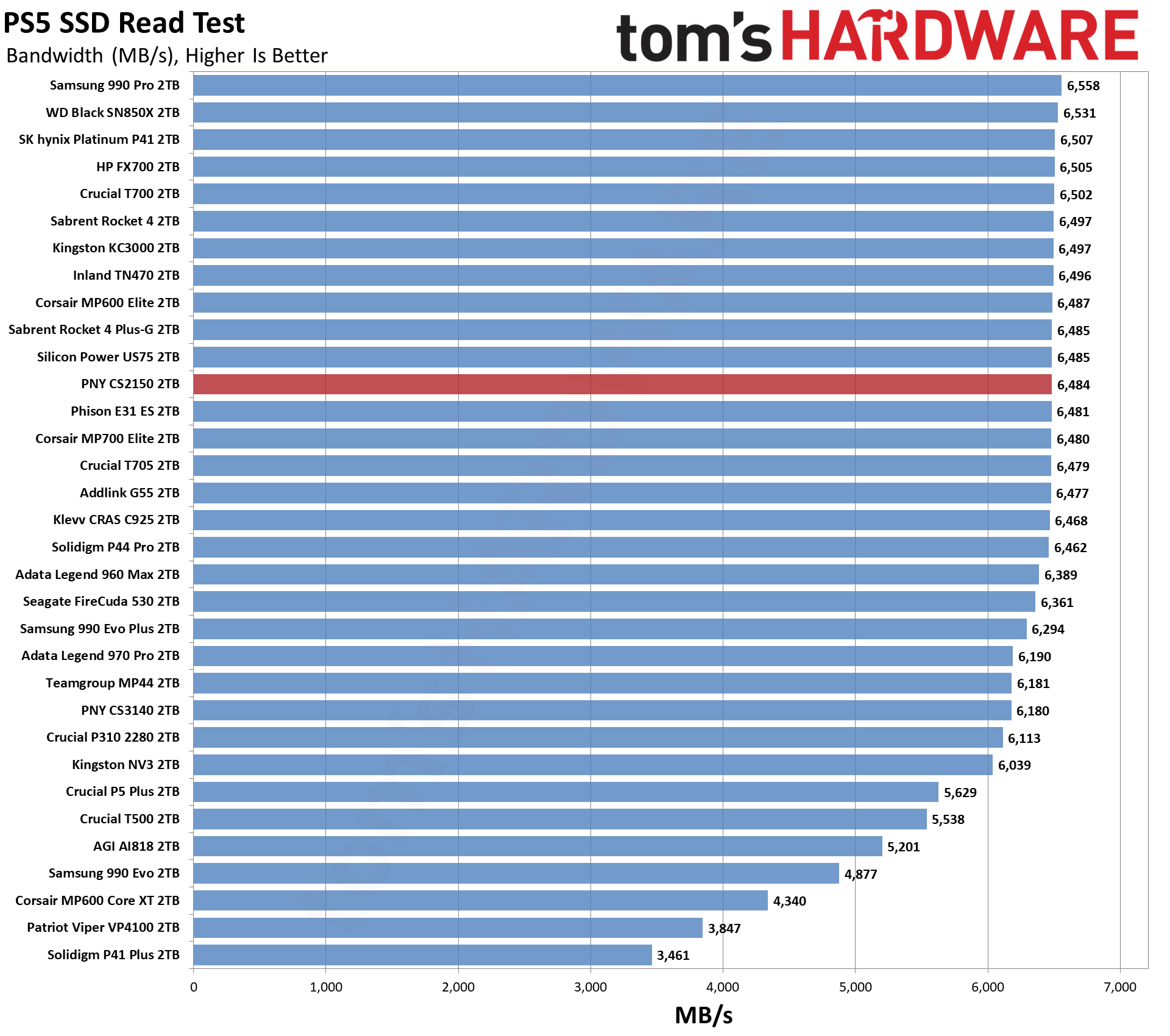
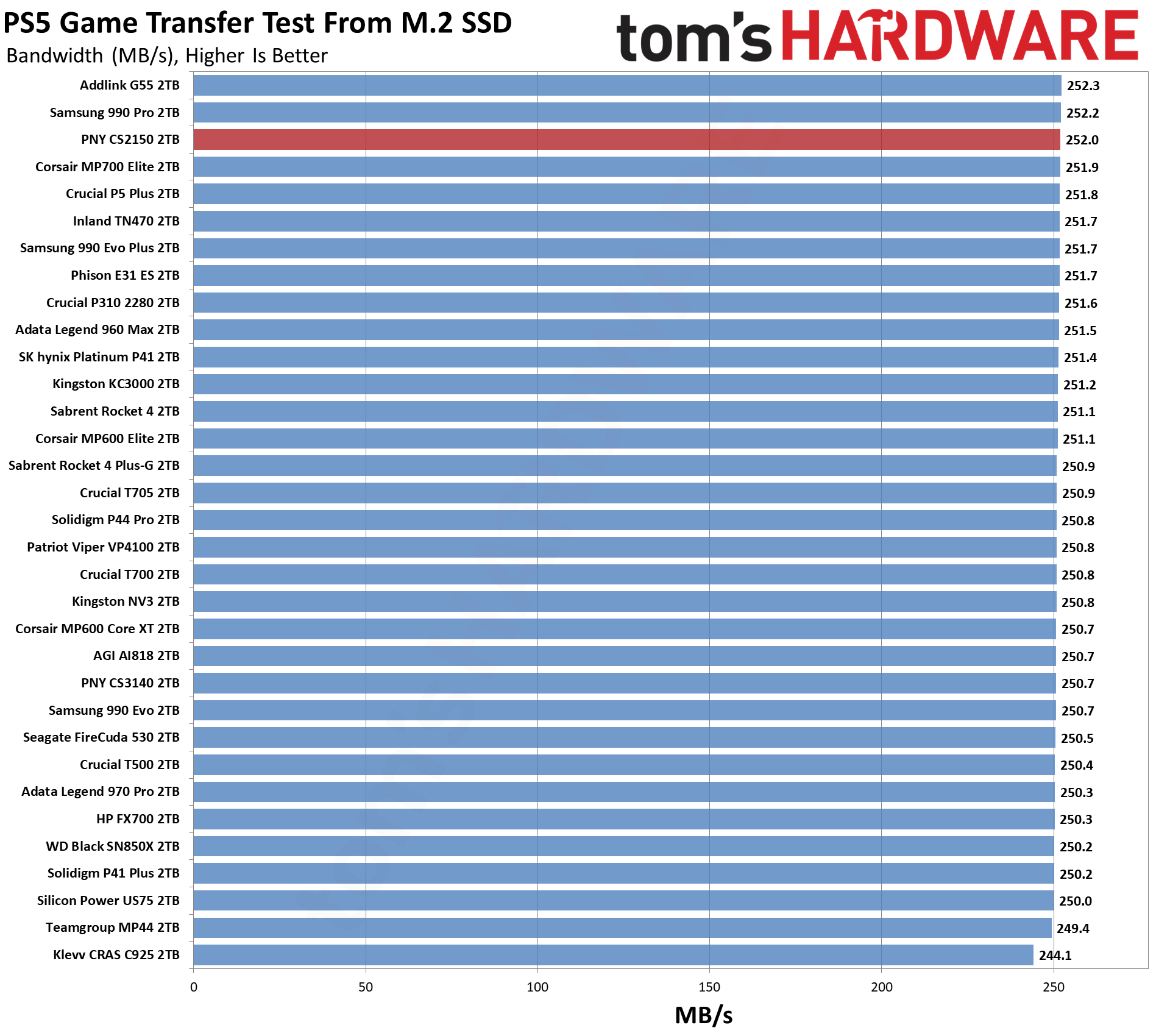
The CS2150 is great for PS5 storage expansion, too. It’s probably not the best choice for that, as you’re not getting any real advantage over less expensive options. Further, the CS2150 is limited to 2TB, so if you’re looking for 4TB or more you'll need to go elsewhere. While the CS2150 should be more efficient and cooler-running than the alternatives, it’s not a significant advantage for PS5 use, especially if you want something that ships with a PS5-compatible heatsink.
Get Tom's Hardware's best news and in-depth reviews, straight to your inbox.
Transfer Rates — DiskBench
We use the DiskBench storage benchmarking tool to test file transfer performance with a custom, 50GB dataset. We write 31,227 files of various types, such as pictures, PDFs, and videos to the test drive, then make a copy of that data to a new folder, and follow up with a reading test of a newly-written 6.5GB zip file. This is a real world type workload that fits into the cache of most drives.

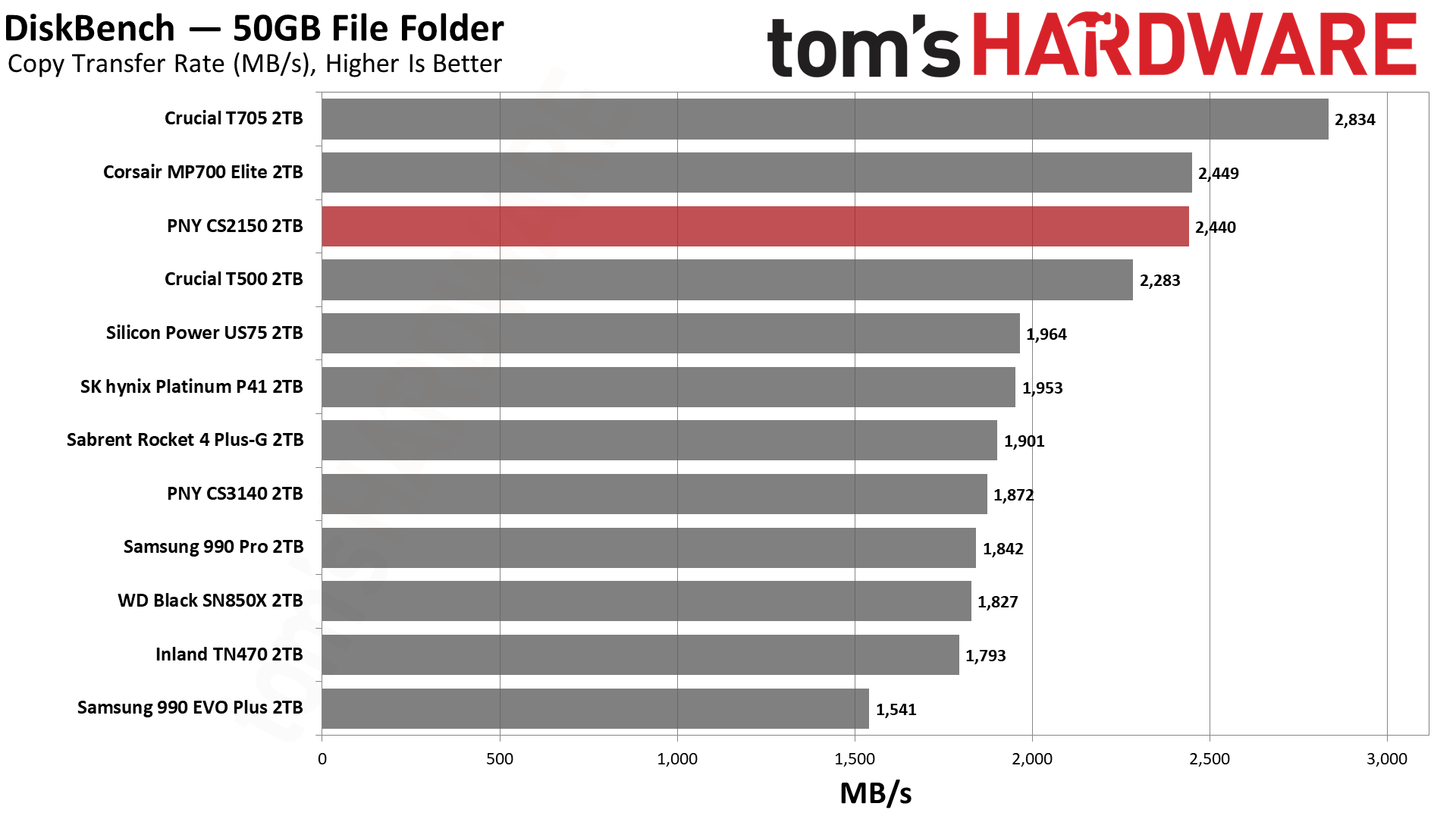
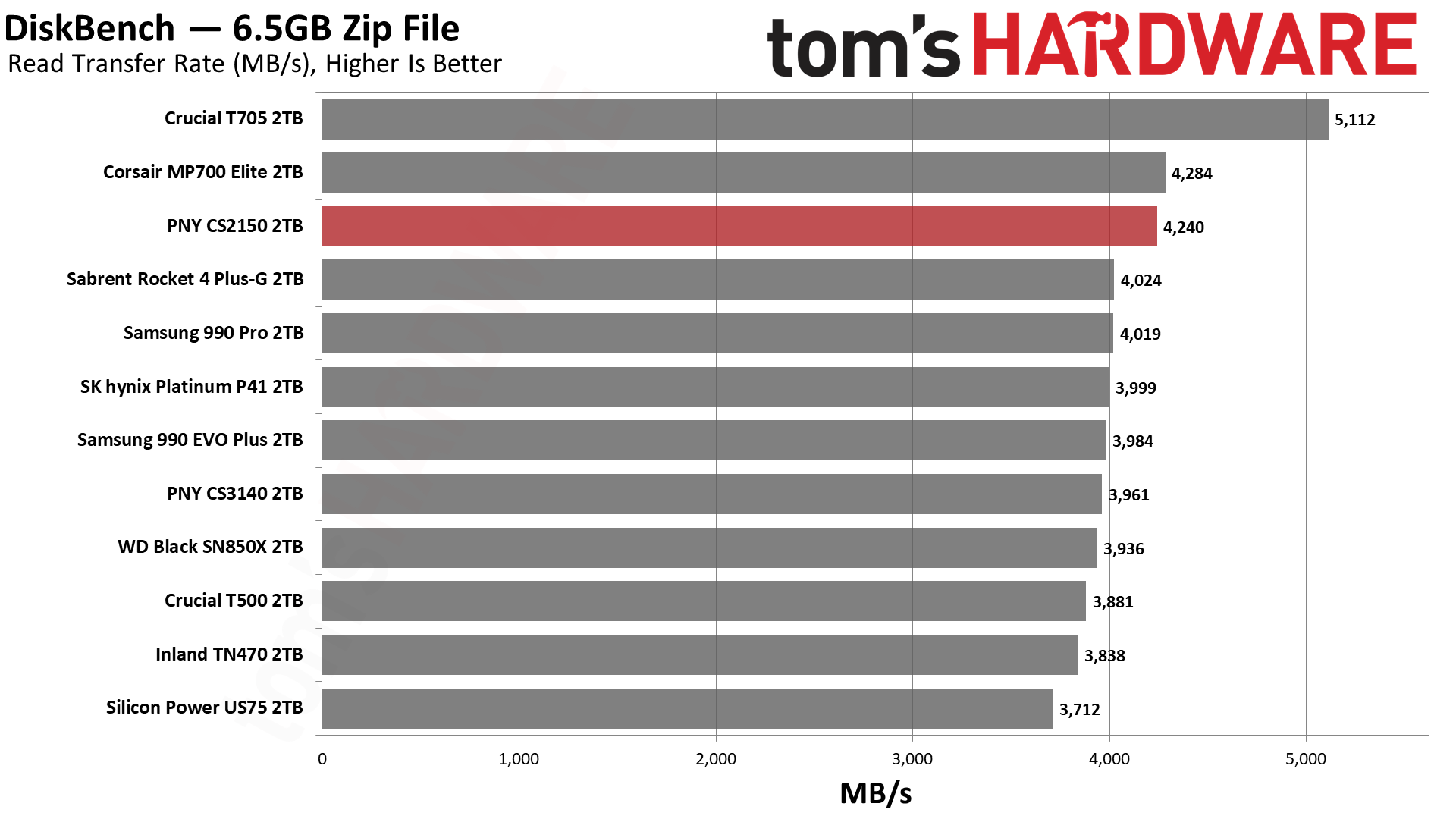
One of the primary reasons to go with a PCIe 5.0 drive is to get better throughput. This benefit is most commonly experienced when doing file transfers. The CS2150 delivers in that respect, reaching over 2.4 GB/s in our copy test. This is significantly above almost all PCIe 4.0 drives with the exception of the T500. While it's not as fast as the T705, the CS2150 still provides a decent improvement on transfer speeds over last-generation SSDs.
Synthetic Testing — ATTO / CrystalDiskMark
ATTO and CrystalDiskMark (CDM) are free and easy-to-use storage benchmarking tools that SSD vendors commonly use to assign performance specifications to their products. Both of these tools give us insight into how each device handles different file sizes and at different queue depths for both sequential and random workloads.
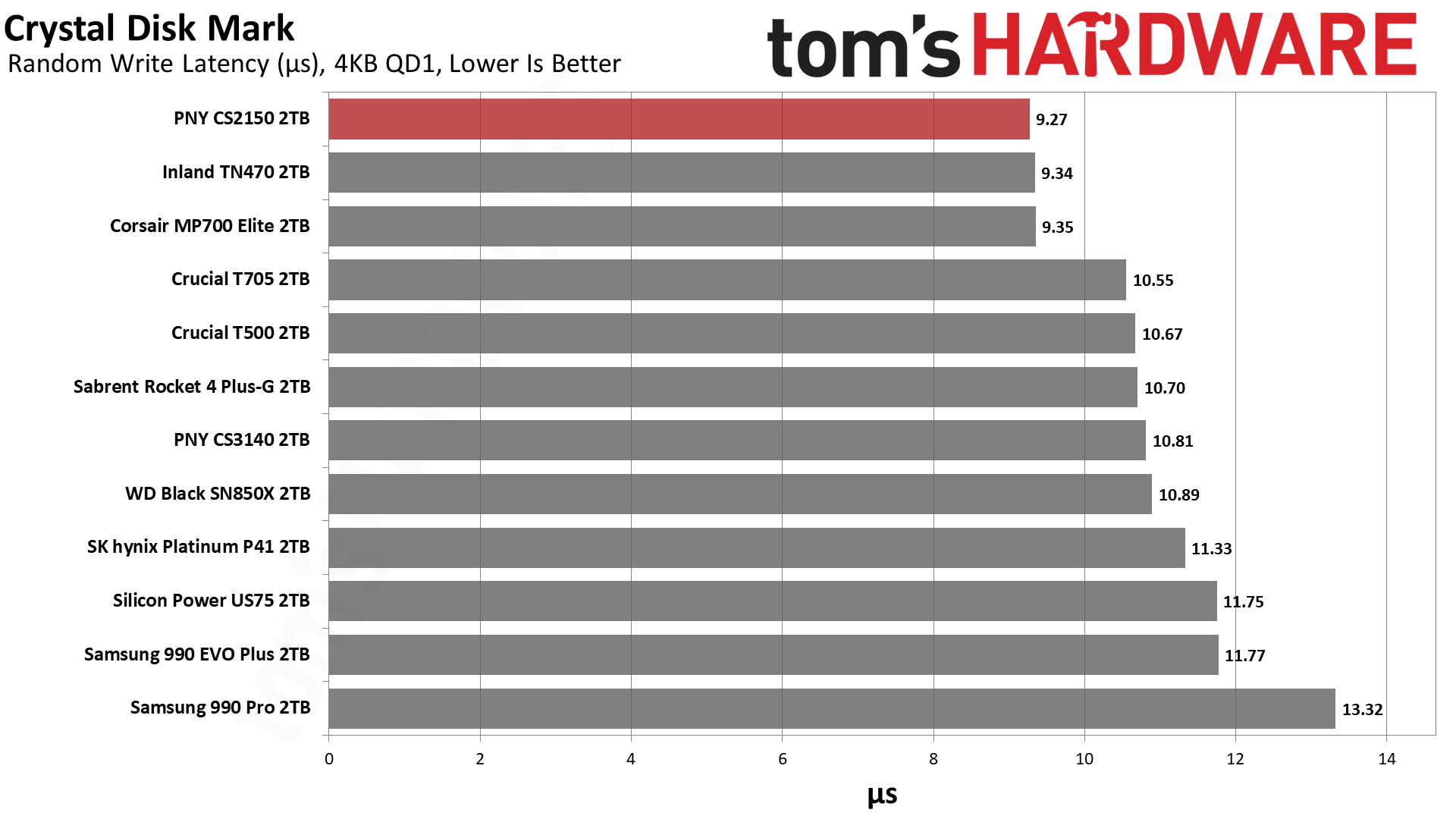
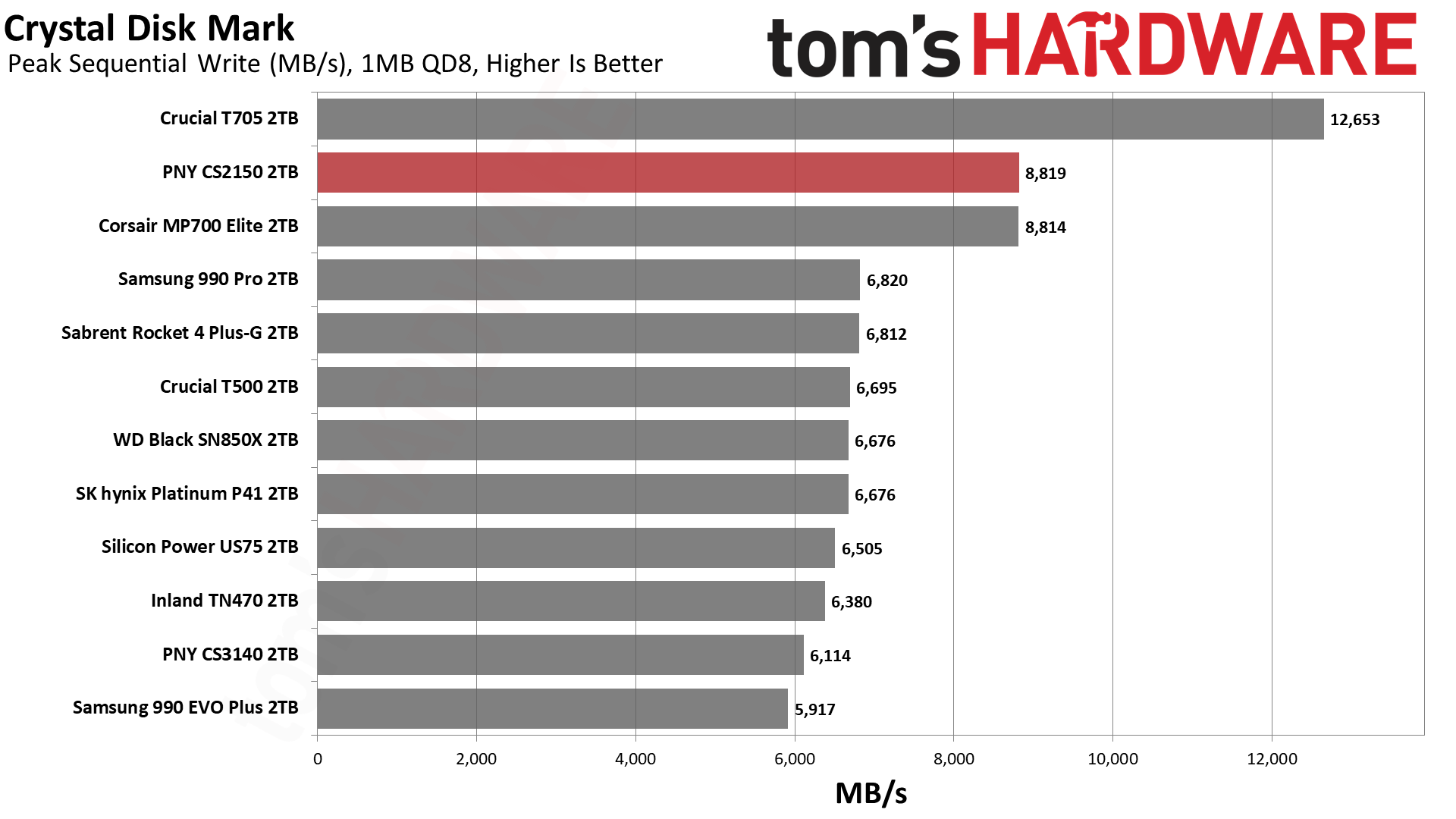
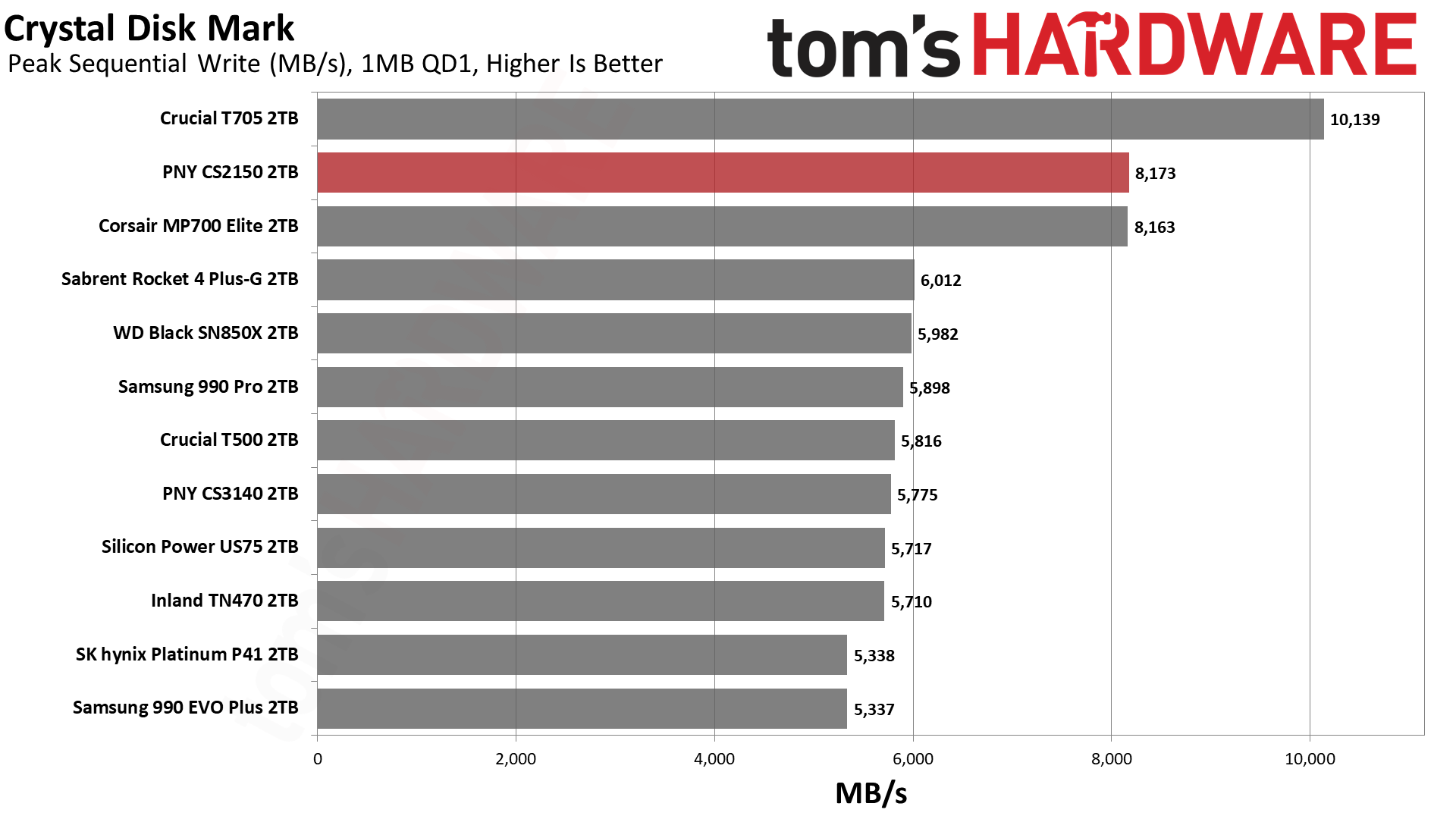
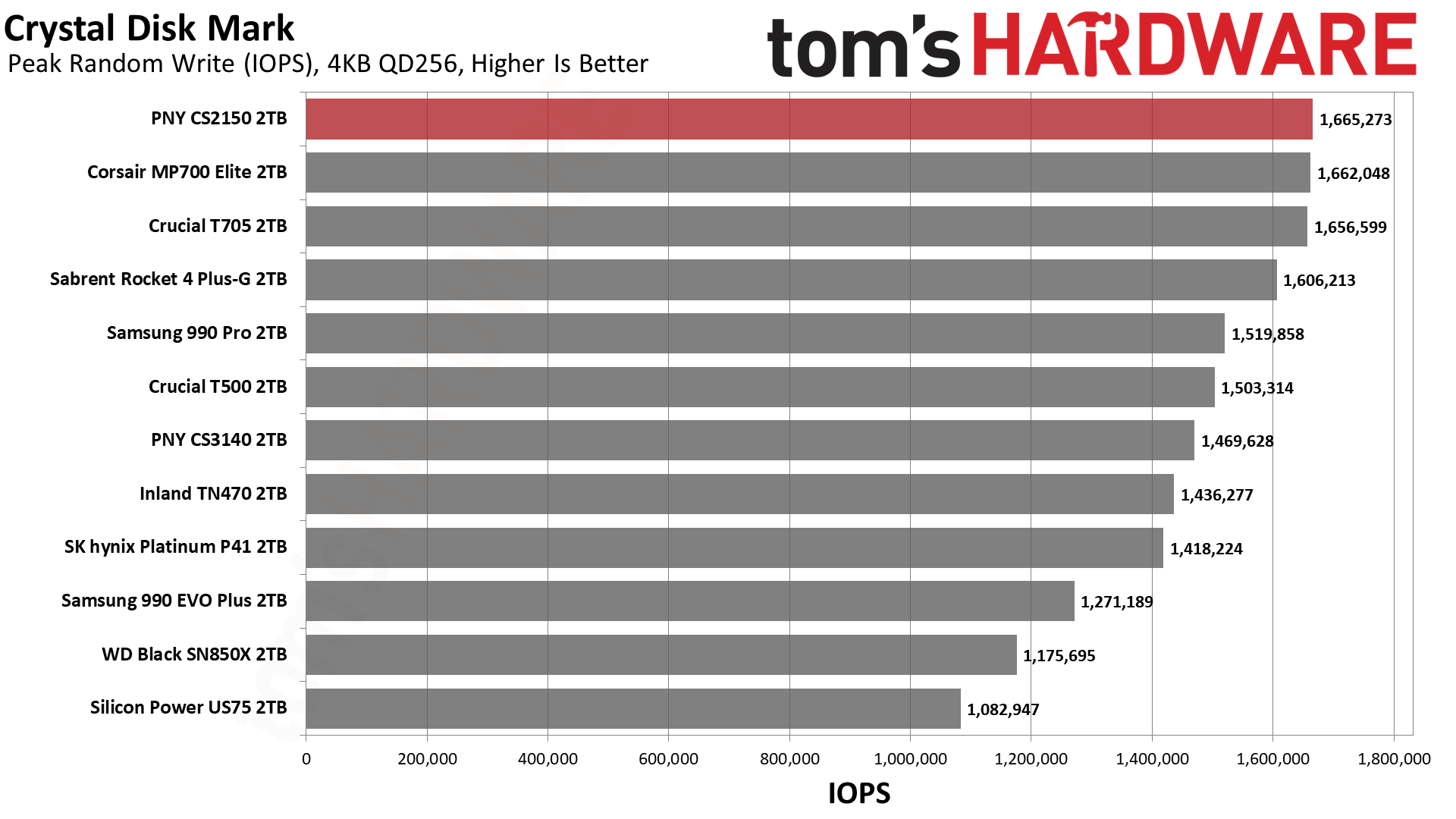

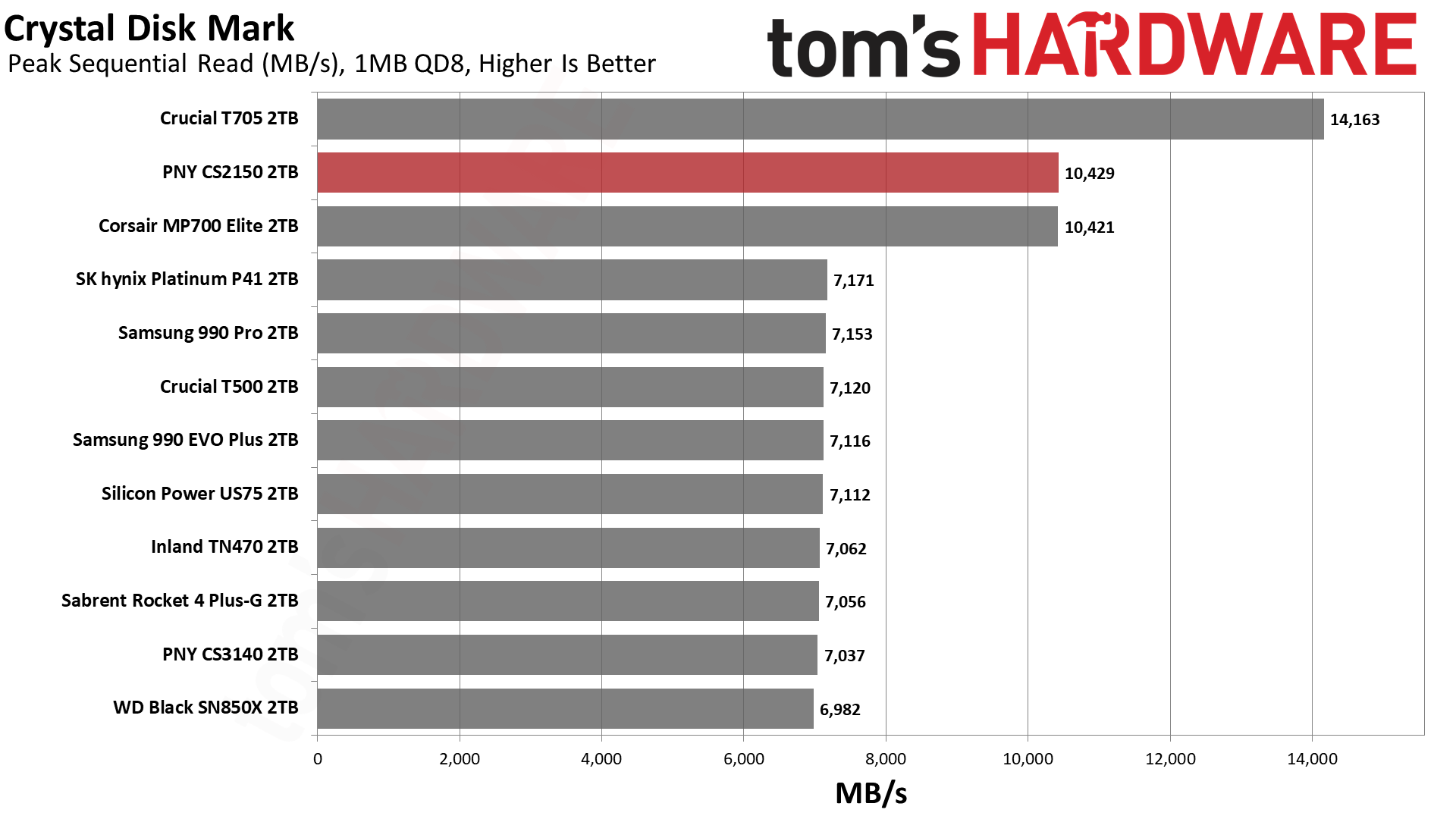
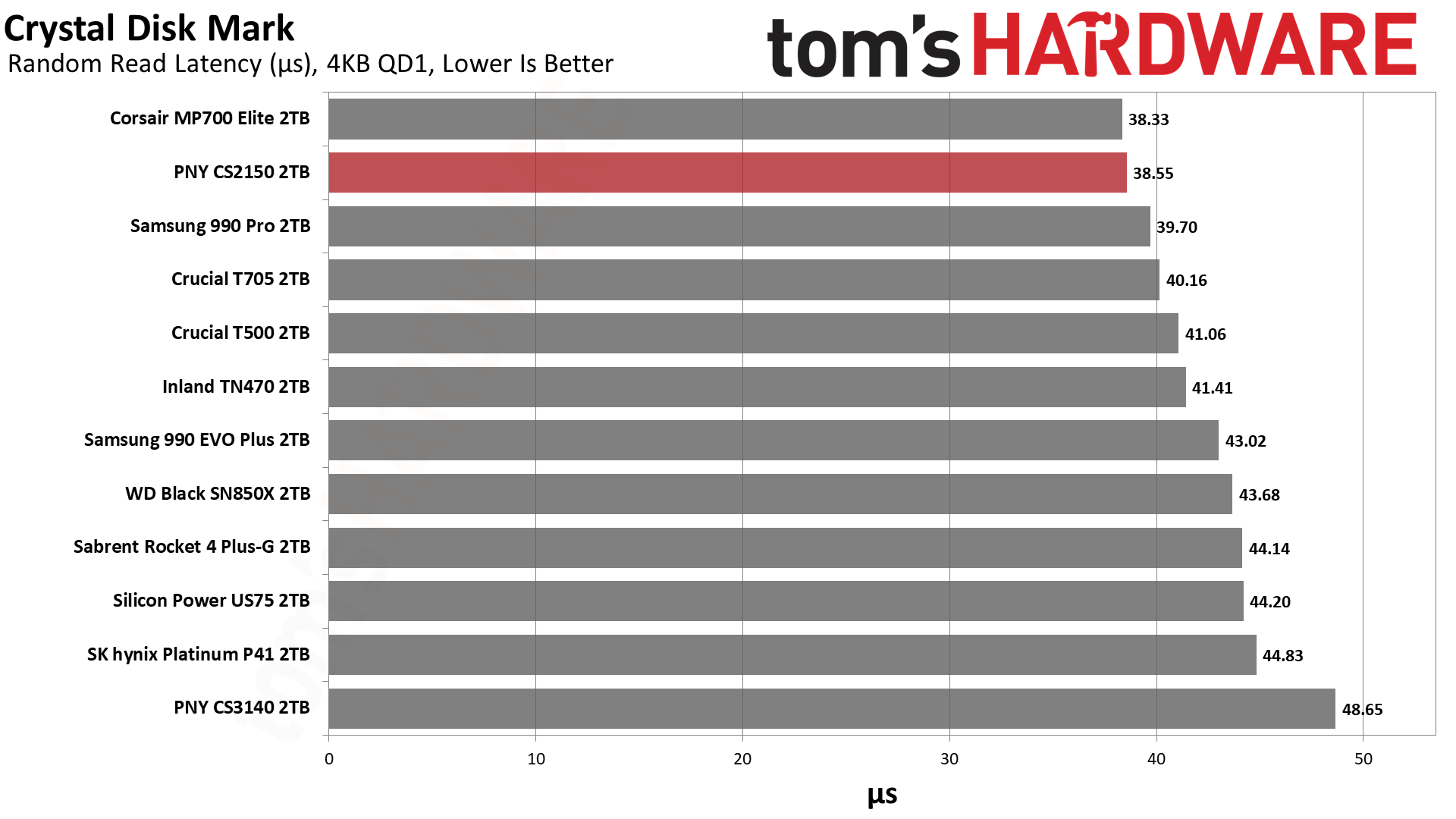
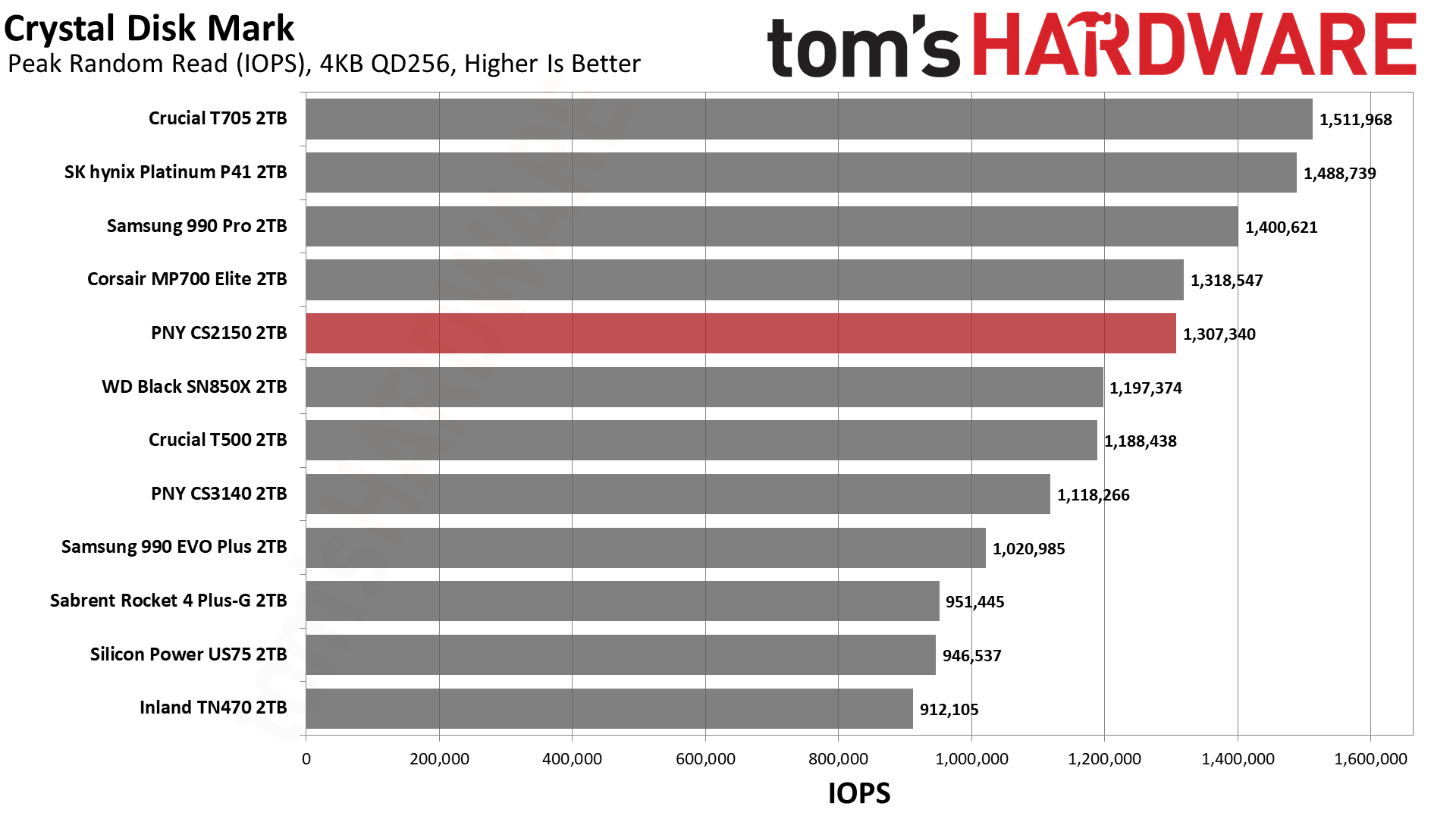
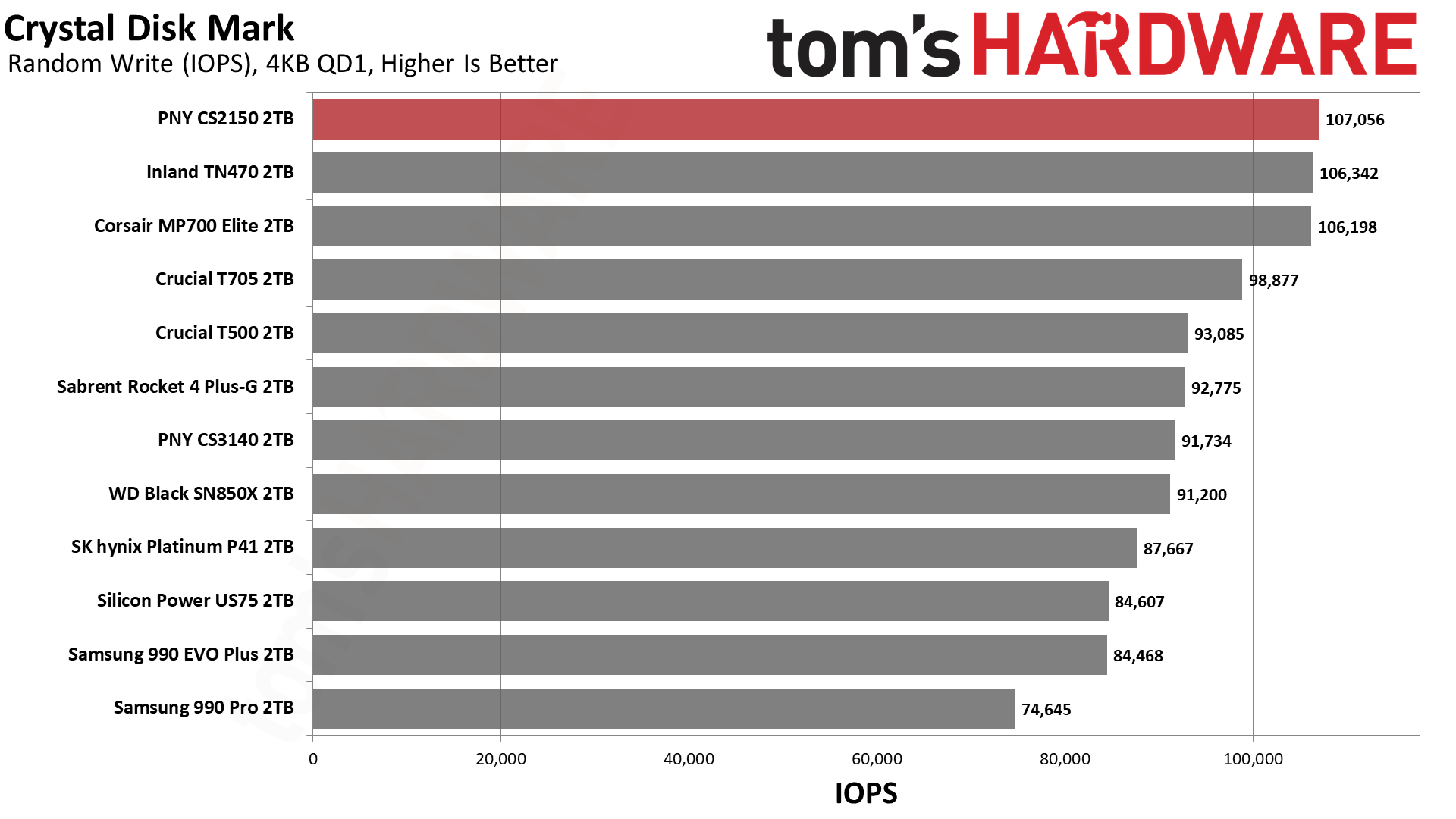
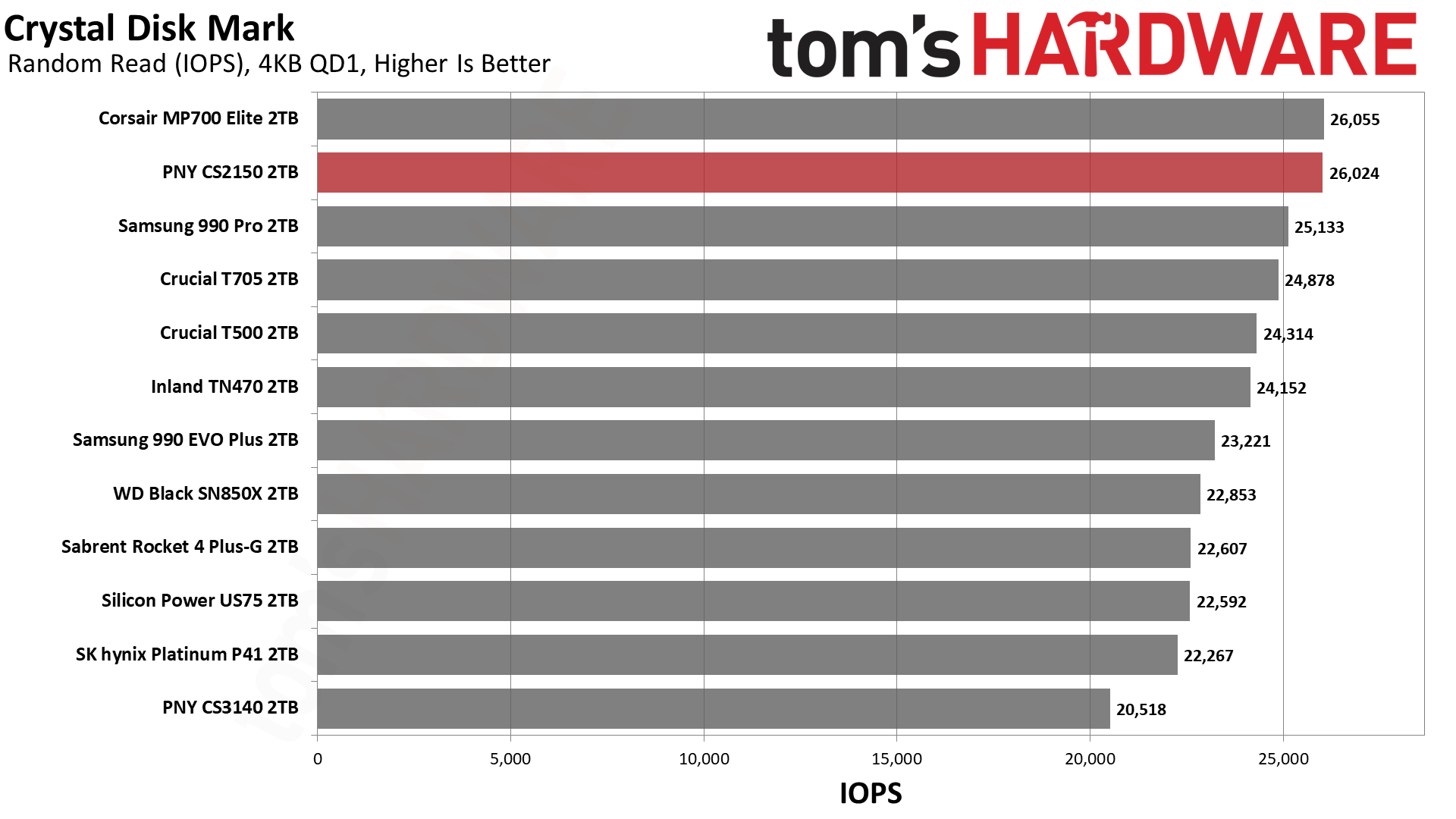
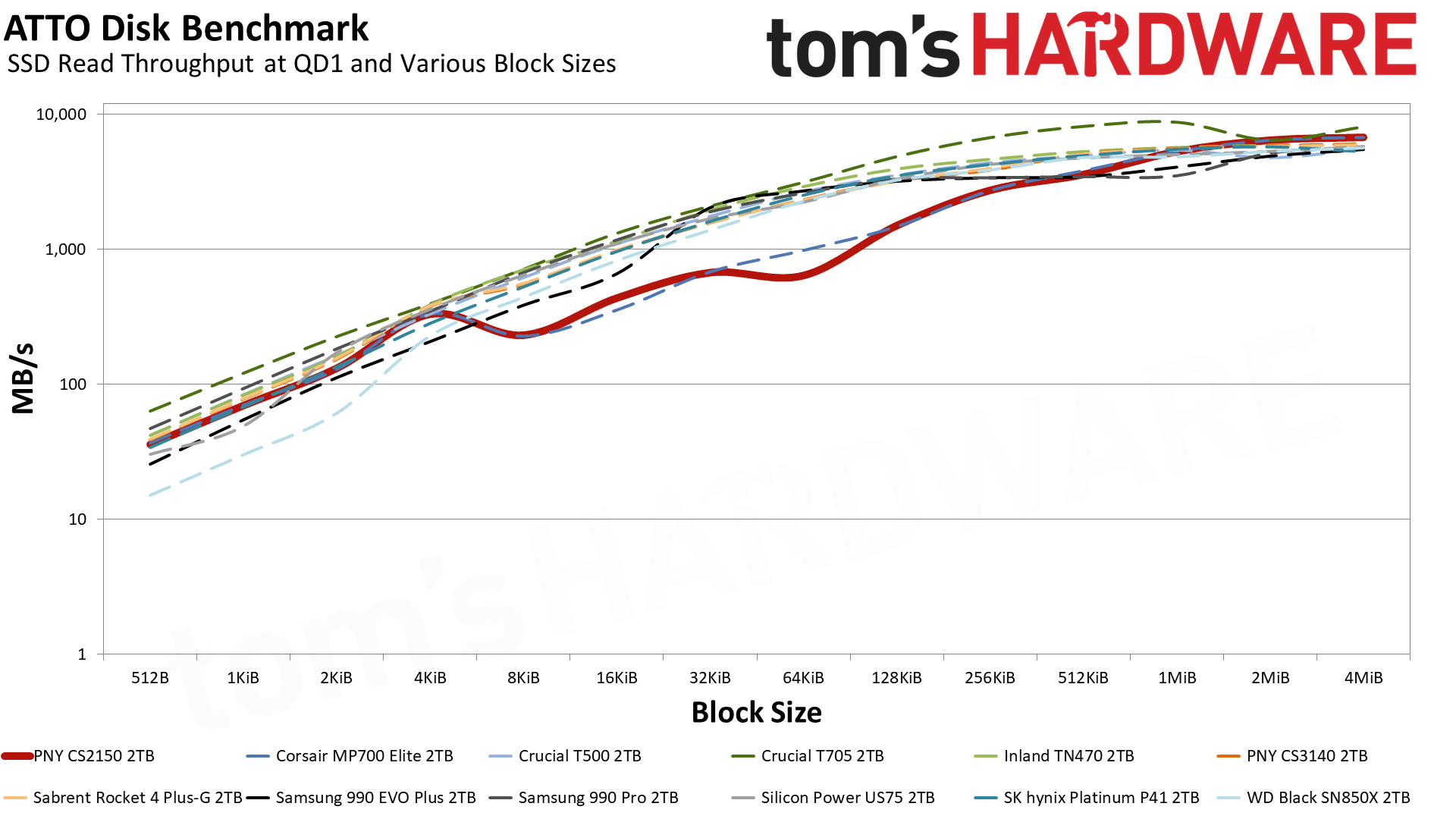
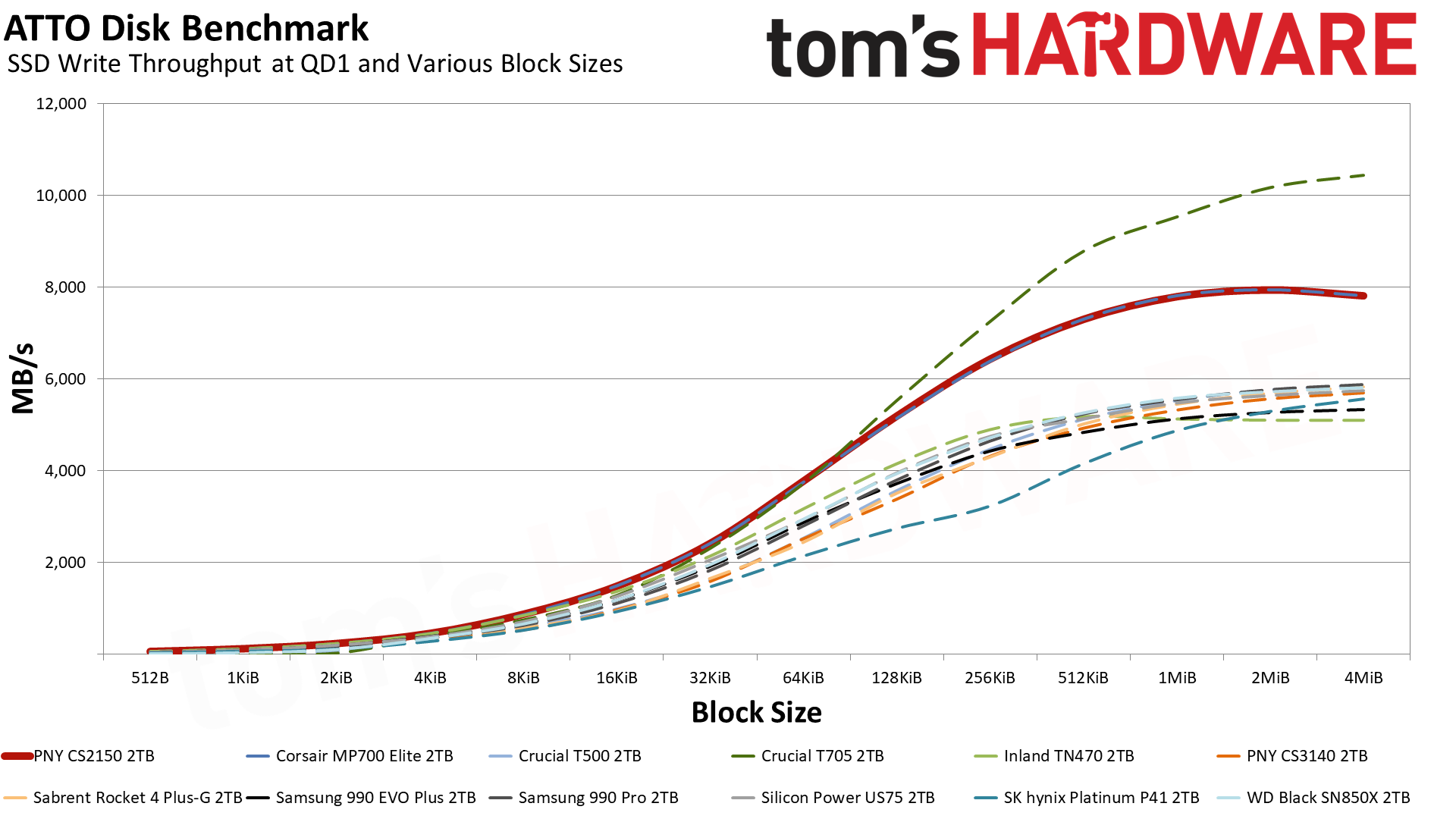
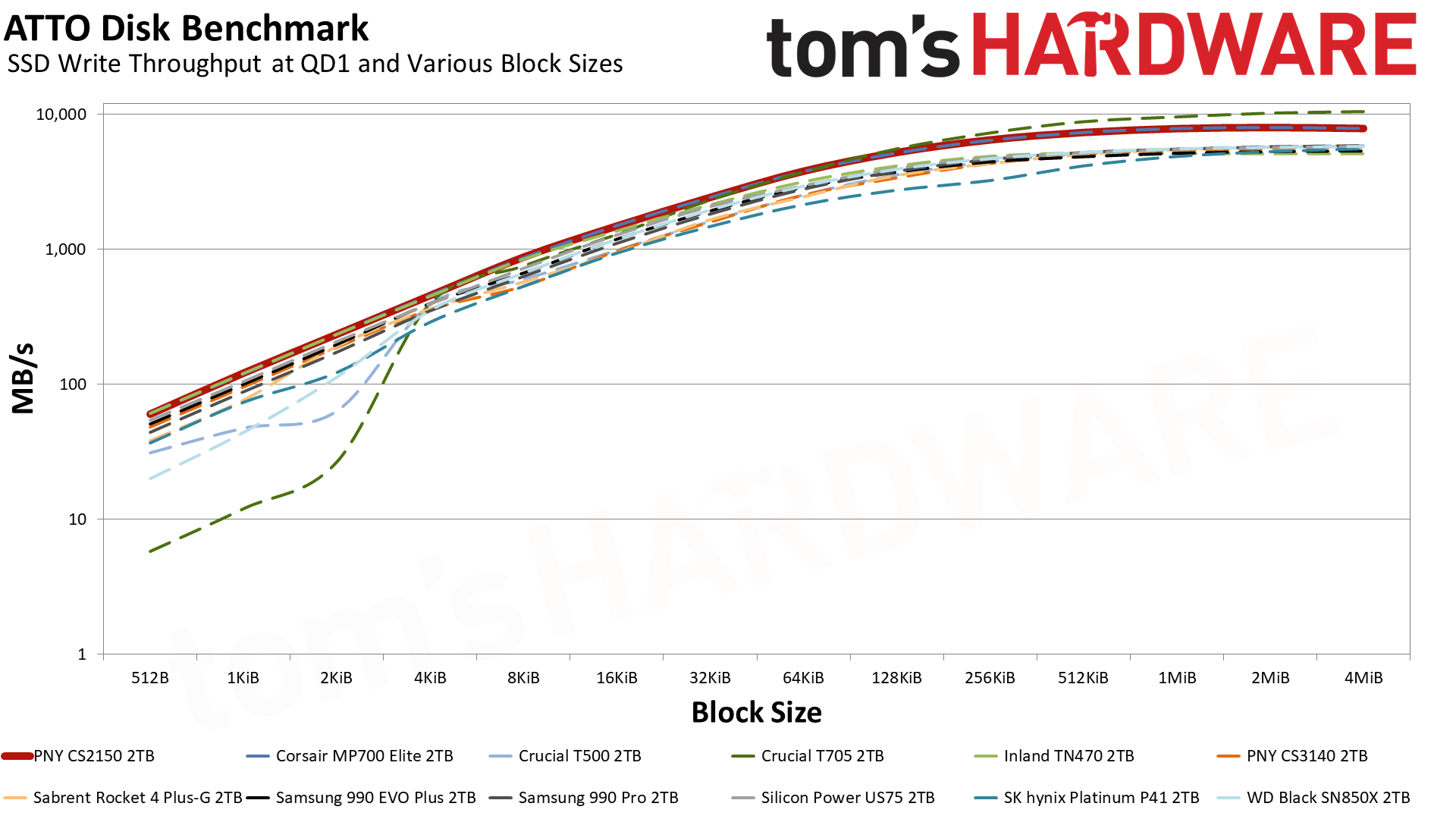
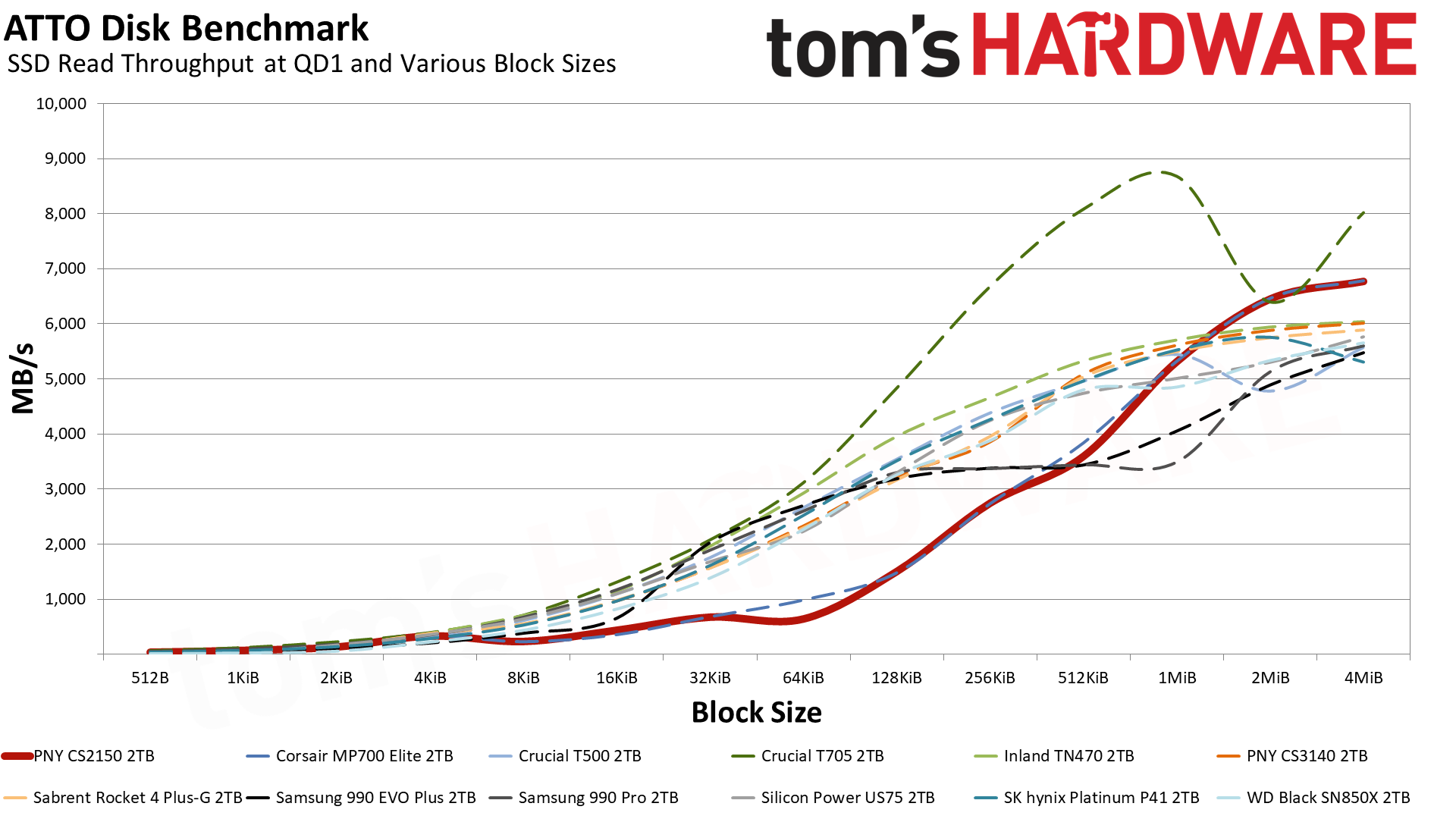
The ATTO results paint a picture of a drive that handles writes excellently but can sometimes struggle with reads. This may be a factor of the controller, the flash, or both. Typically, a drive’s result at the 4KiB block size is most important for real-world feel and the CS2150 does very well there. It then seems to struggle a little bit — along with the MP700 Elite — until 128KiB.
Given the layout of the flash, which is quad-plane, this might simply be a matter of reaching sufficient interleaving. This wouldn’t be a bad trade-off for the exceptional 4K performance we’ve seen from drives using this flash like the Black SN7100. In that case WD — or SanDisk — may have had the opportunity to optimize more closely for BiCS 8 than Phison with the CS2150’s E31T controller.
CDM perfectly reflects this understanding of the hardware as the CS2150 isn’t too great with QD1 sequential reads but is solid everywhere else, especially when considering 4K random read latency. This makes for a snappy drive that can also hold up under heavier workloads. It’s not perfect and DRAM-equipped drives like the T500 can surpass it in some areas, but overall the desktop performance should be second to none.
Sustained Write Performance and Cache Recovery
Official write specifications are only part of the performance picture. Most SSDs implement a write cache, which is a fast area of pseudo-SLC (single-bit) programmed flash that absorbs incoming data. Sustained write speeds can suffer tremendously once the workload spills outside of the cache and into the "native" TLC (three-bit) or QLC (four-bit) flash. Performance can suffer even more if the drive is forced to fold, which is the process of migrating data out of the cache in order to free up space for further incoming data.
We use Iometer to hammer the SSD with sequential writes for over 15 minutes to measure both the size of the write cache and performance after the cache is saturated. We also monitor cache recovery via multiple idle rounds. This process shows the performance of the drive in various states as well as the steady state write performance.
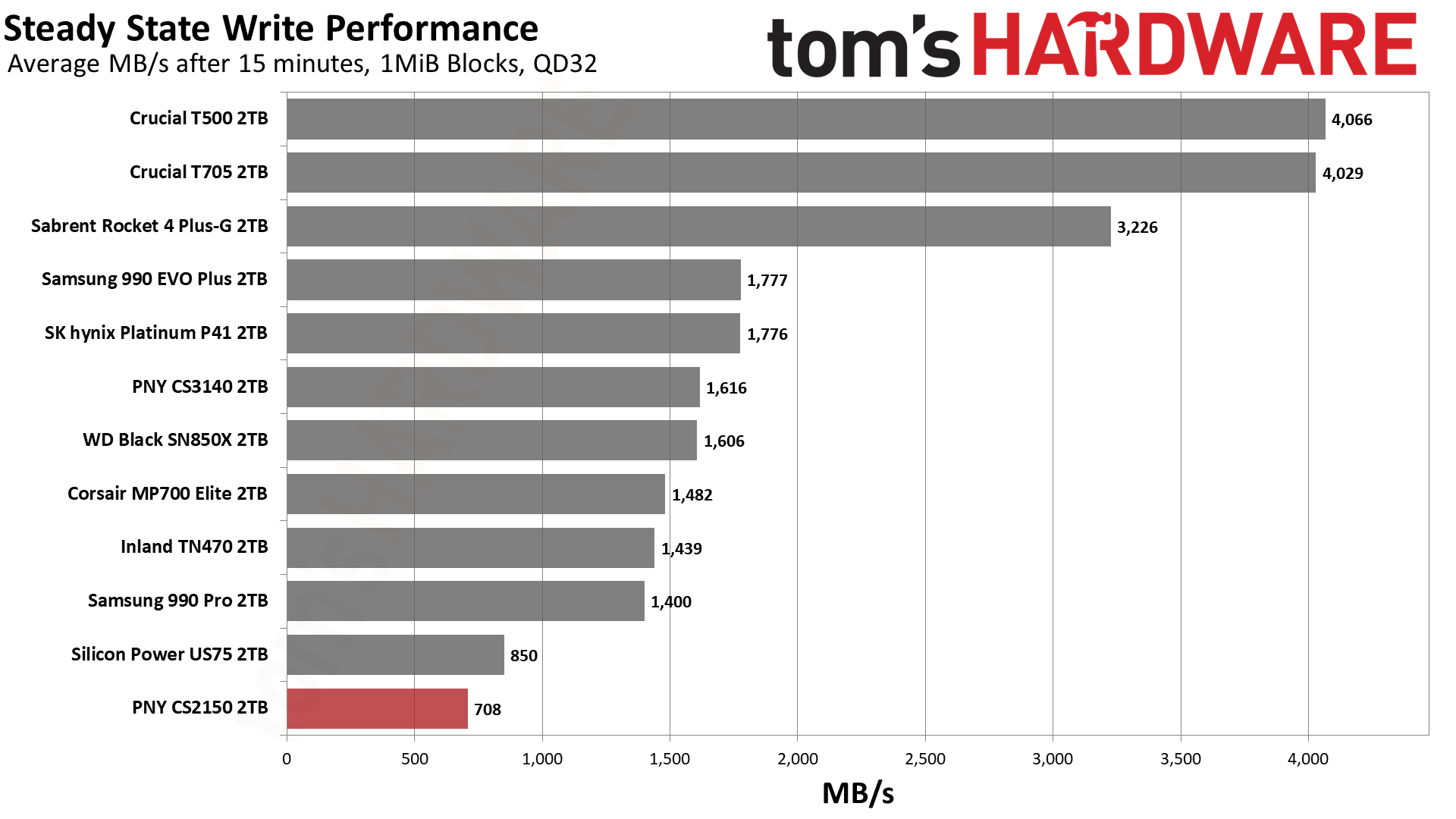
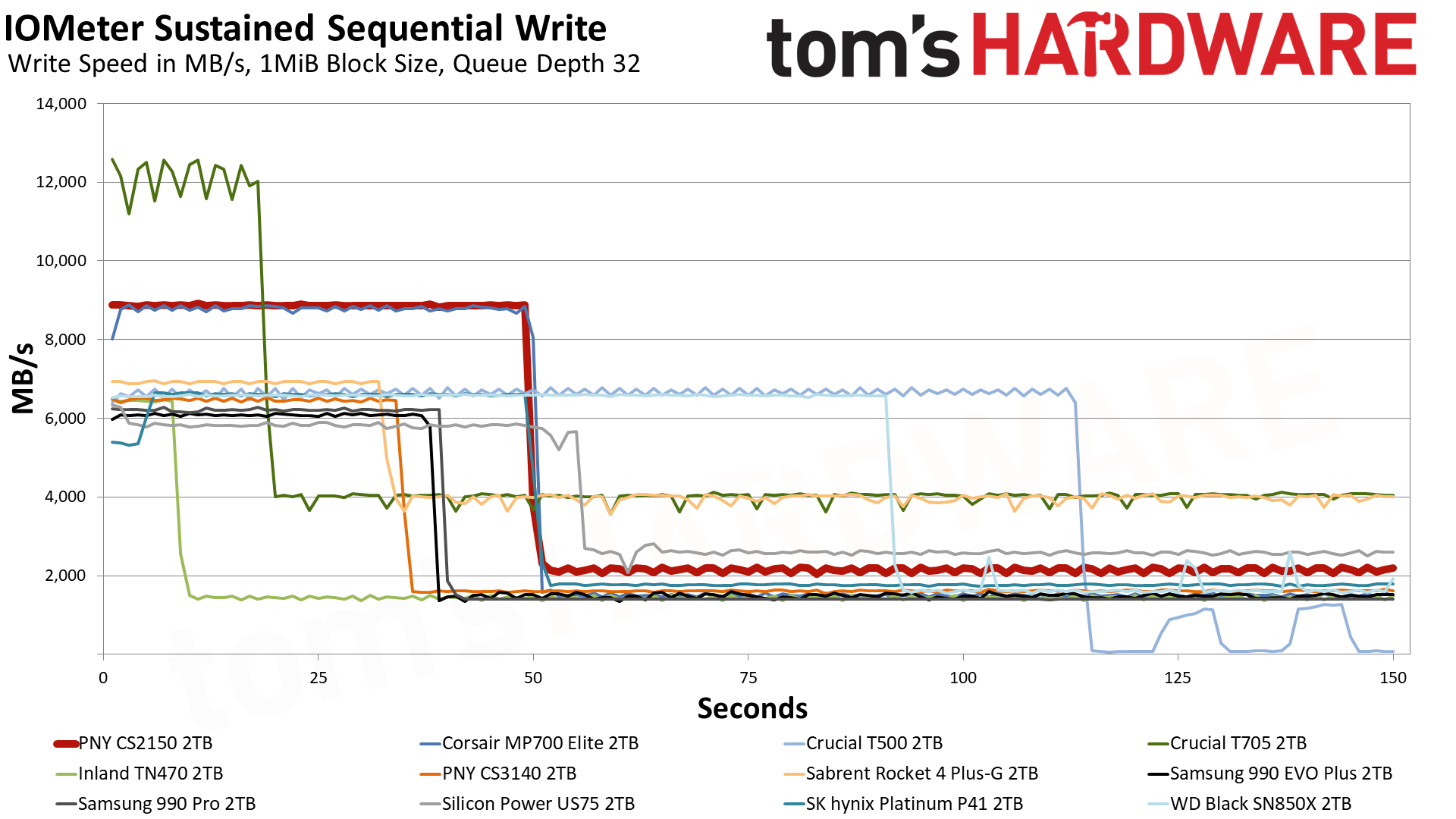
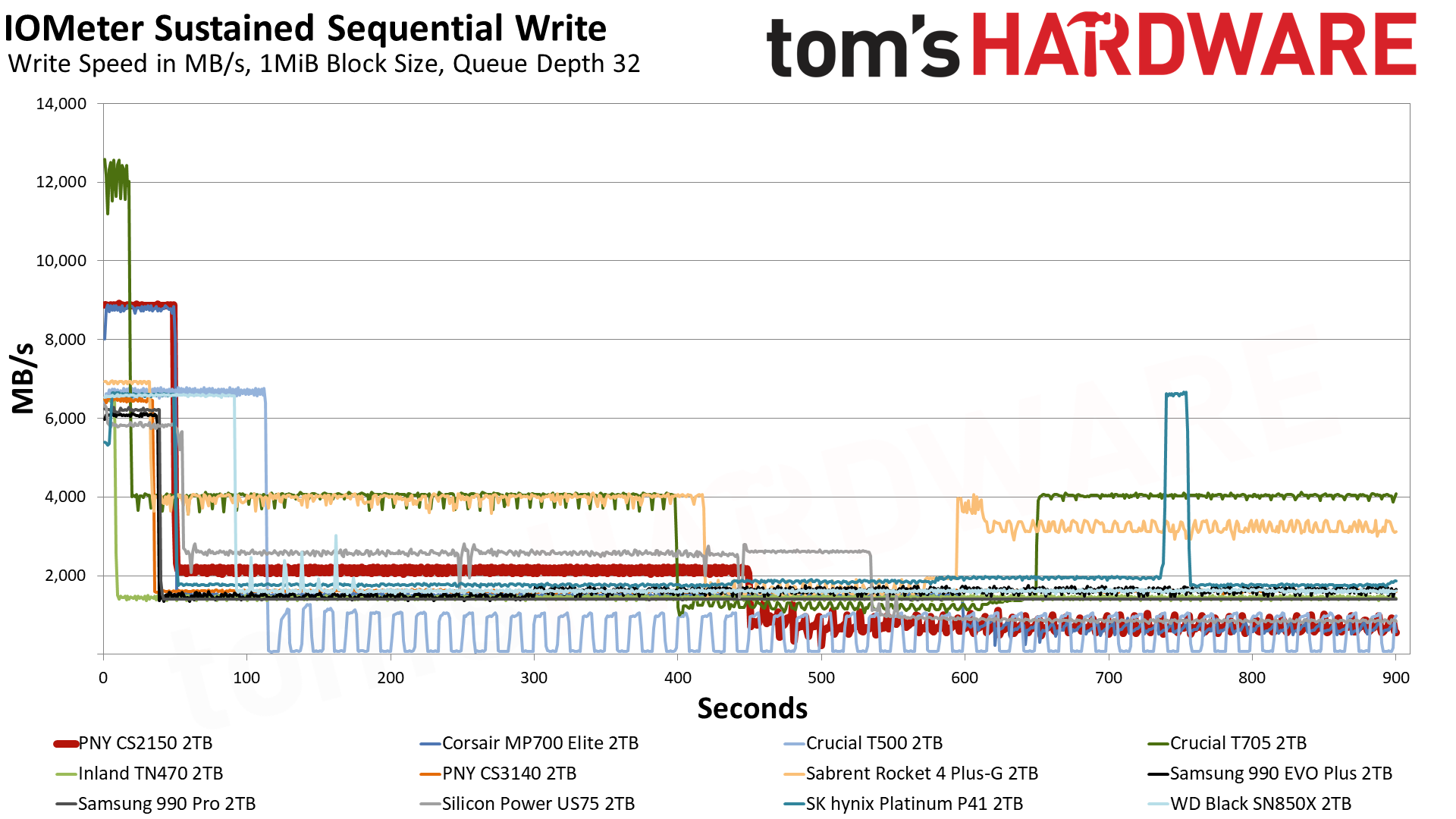
The 2TB CS2150 writes in the single-bit SLC mode at an average of almost 8.9 GB/s for about 50 seconds, indicating a 435GB cache. This is a large cache but by no means as large as it could be given the size of the drive. A smaller cache allows for a higher middle performance state, in this case a three-bit TLC mode that writes at around 2.15 GB/s. Finally, once the cache is completely full and needs to be emptied to allow access to the full drive capacity, that forces the drive to enter the slowest “folding” state. Here the drive writes at an average of 708 MB/s while juggling data.
The CS2150’s peak writing performance is good but far from the best we’ve seen. This is to be expected of a four-channel drive that can only access so much flash at once. This limitation also reduces performance in the states outside of the cache, although the performance in the TLC mode is quite good for what it is. Ultimately, this drive doesn’t have too much trouble with sustained writes in most cases, but for specific workloads it would be wiser to jump up to an eight-channel drive with DRAM like the T705 or — in the future — something that uses the same hardware as the Micron 4600 or equivalent.
Power Consumption and Temperature
We use the Quarch HD Programmable Power Module to gain a deeper understanding of power characteristics. Idle power consumption is an important aspect to consider, especially if you're looking for a laptop upgrade as even the best ultrabooks can have mediocre stock storage. Desktops may be more performance-oriented with less support for power-saving features, so we show the worst-case.
Some SSDs can consume watts of power at idle while better-suited ones sip just milliwatts. Average workload power consumption and max consumption are two other aspects of power consumption but performance-per-watt, or efficiency, is more important. A drive might consume more power during any given workload, but accomplishing a task faster allows the drive to drop into an idle state more quickly, ultimately saving energy.
For temperature recording we currently poll the drive’s primary composite sensor during testing with a ~22°C ambient. Our testing is rigorous enough to heat the drive to a realistic ceiling temperature.
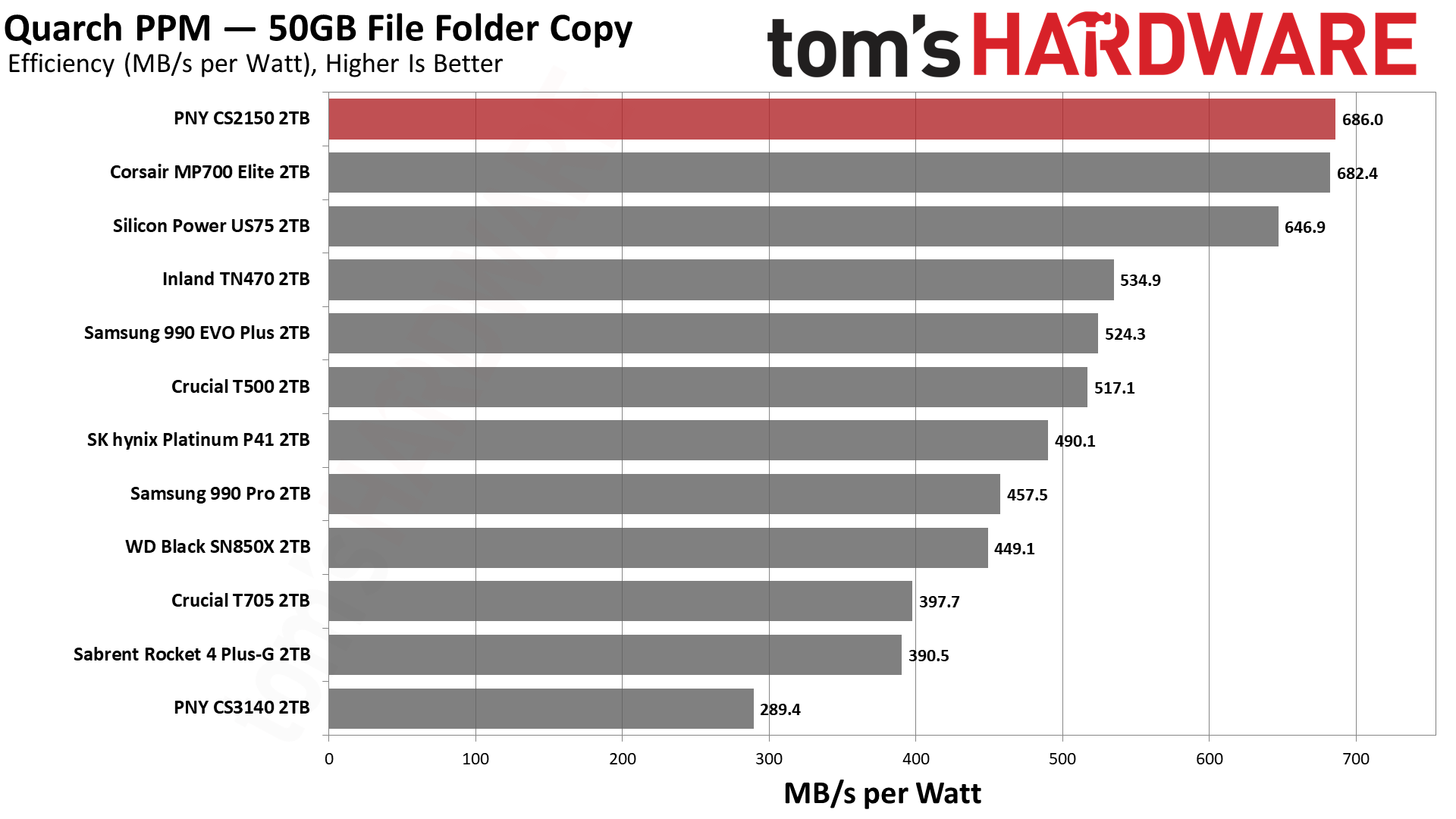
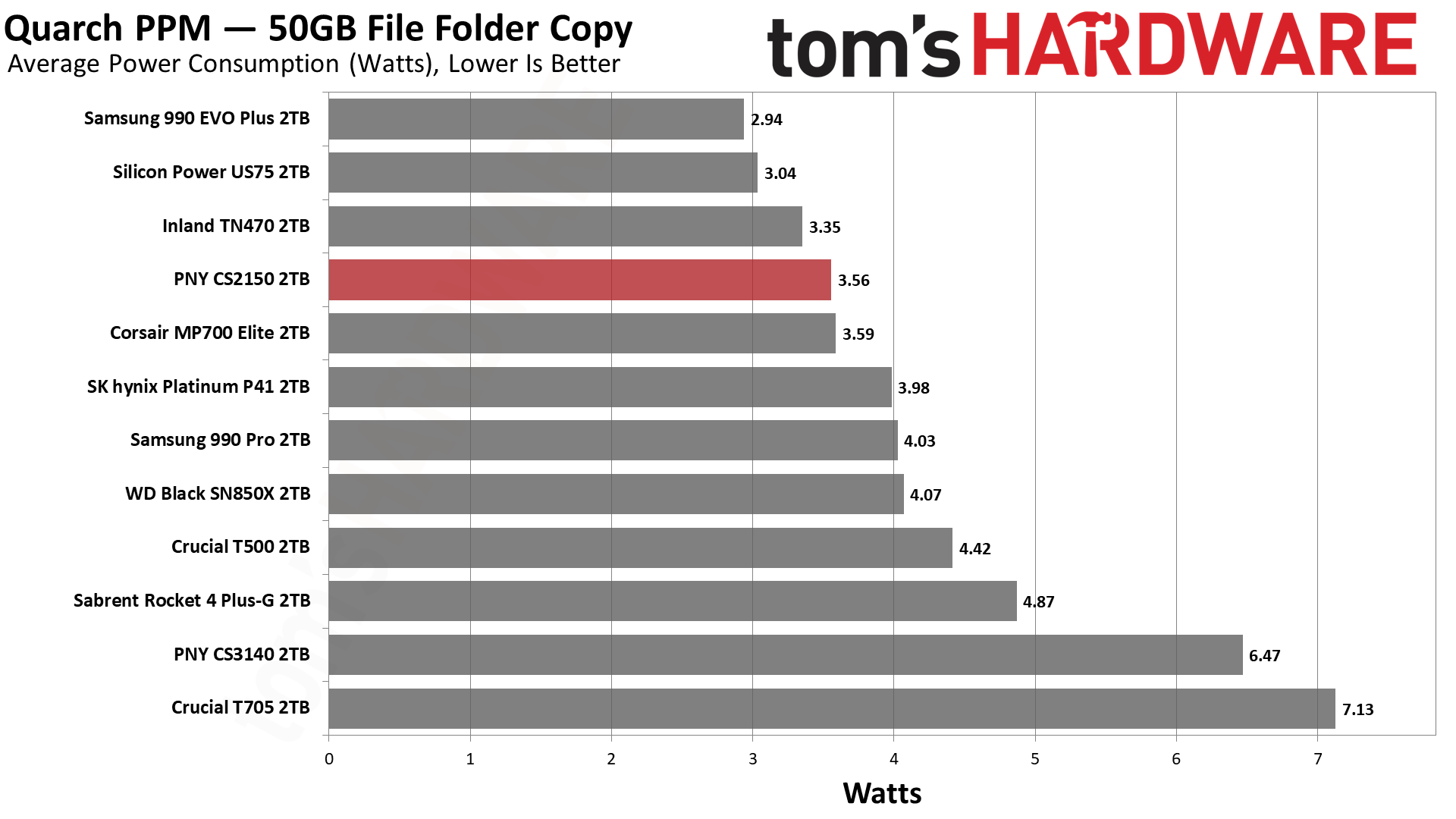
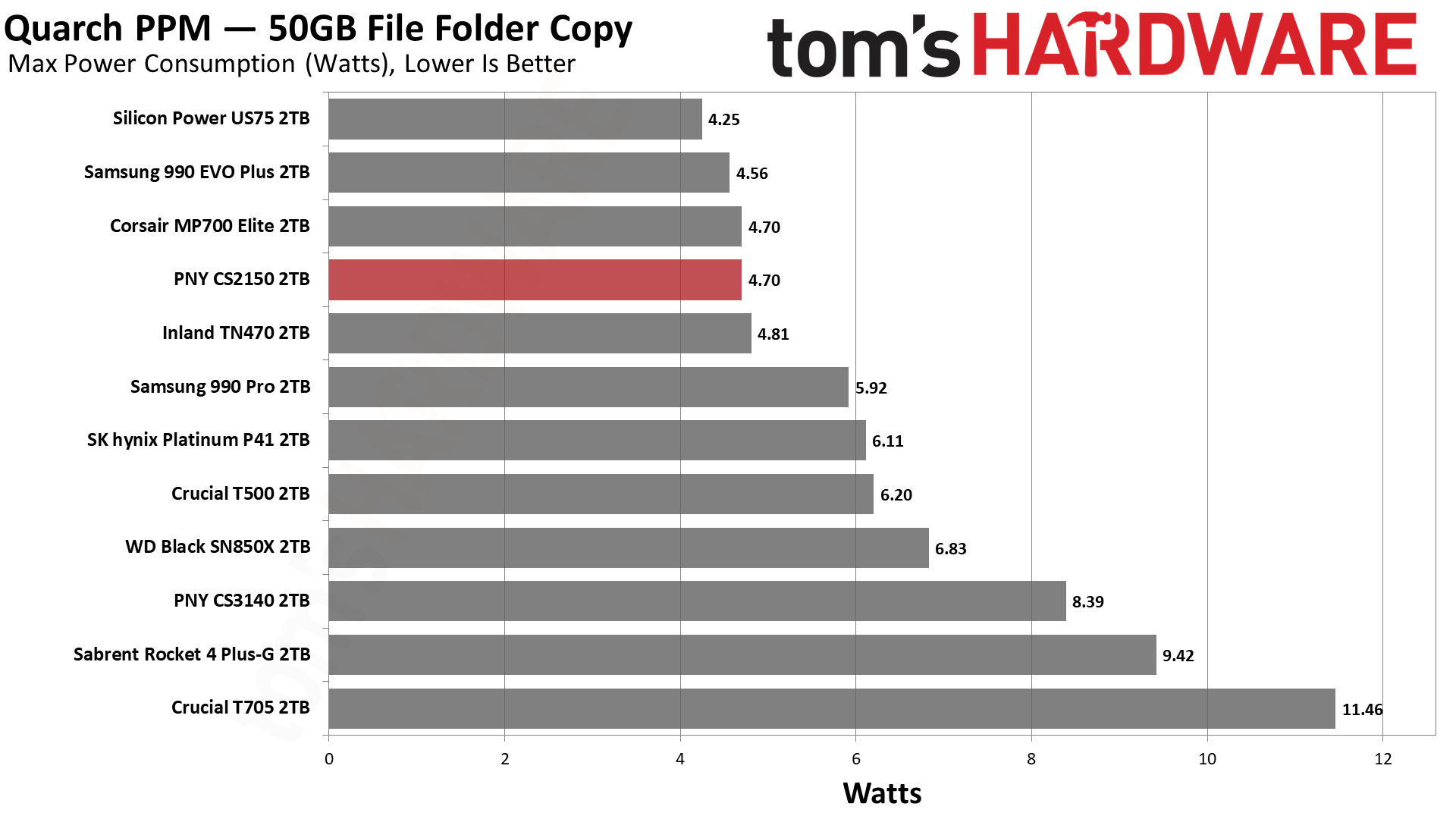
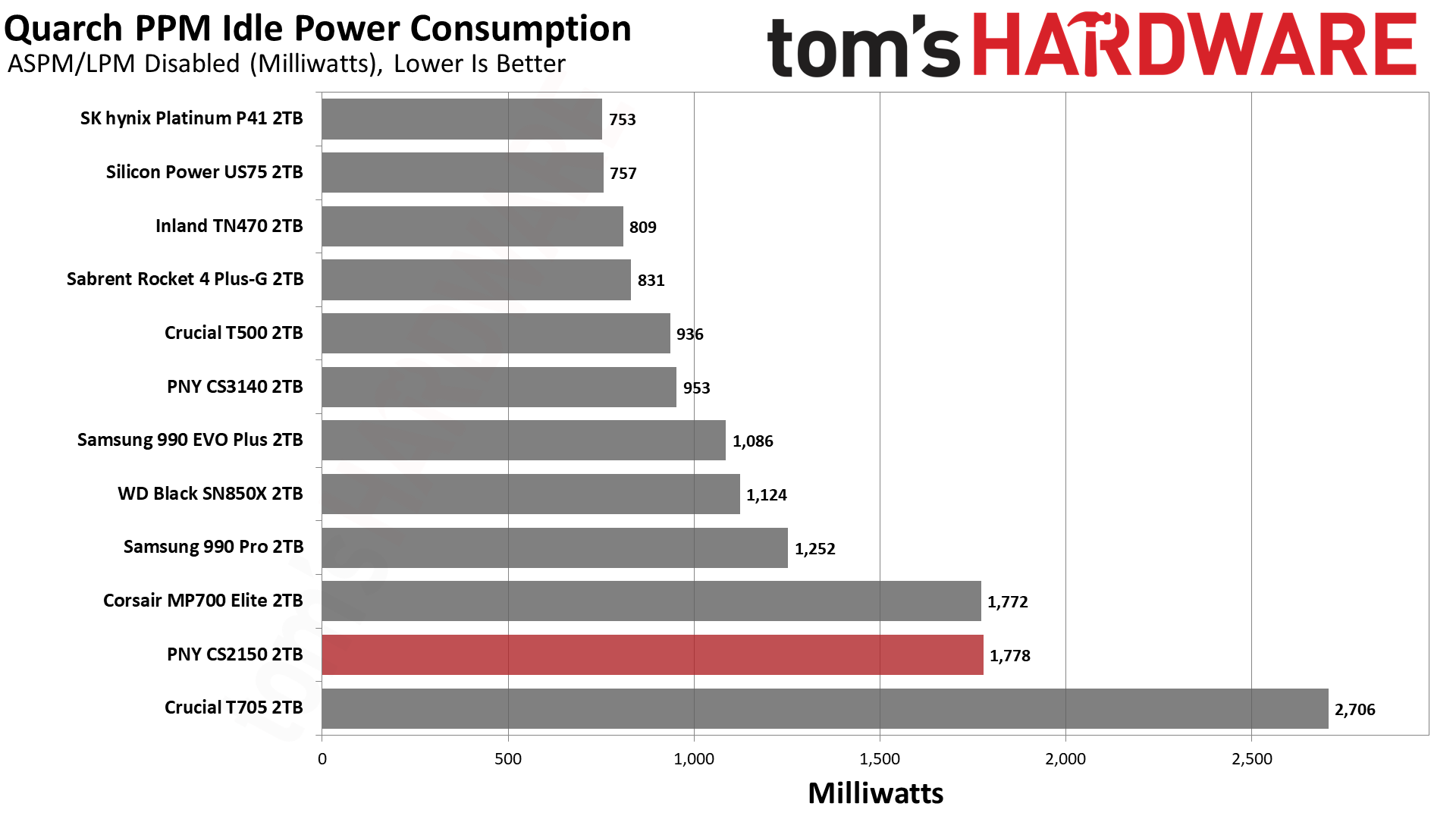
The CS2150 is exceptionally efficient, second only to the Black SN7100 from WD. In practice, given its PCIe 5.0 interface, this is about as good as it gets. When run in a PCIe 4.0 system, the CS2150 would be even more efficient. Less power generally means less heat, too, so this drive is an excellent choice for even thermally-challenging environments such as those found in gaming laptops and small form factor HTPCs.
With an average power consumption of 3.56W, the CS2150 only reached a maximum of 58°C in our testing, which is an excellent result that leaves 25°C of headroom before throttling. This is one cool customer. (Note that our test system does have active cooling.)
Test Bench and Testing Notes
CPU | Row 0 - Cell 2 | |
Motherboard | Row 1 - Cell 2 | |
Memory | Row 2 - Cell 2 | |
Graphics | Intel Iris Xe UHD Graphics 770 | Row 3 - Cell 2 |
CPU Cooling | Row 4 - Cell 2 | |
Case | Row 5 - Cell 2 | |
Power Supply | Row 6 - Cell 2 | |
OS Storage | Row 7 - Cell 2 | |
Operating System | Row 8 - Cell 2 |
We use an Alder Lake platform with most background applications such as indexing, Windows updates, and anti-virus disabled in the OS to reduce run-to-run variability. Each SSD is prefilled to 50% capacity and tested as a secondary device. Unless noted, we use active cooling for all SSDs.
PNY CS2150 Bottom Line
The PNY CS2150 is a great drive that demonstrates what’s possible with newer flash and controller technology. It’s a clear improvement over the PCIe 3.0 generation of SSDs in every way, so those holding onto the belief that all SSDs are created equal will have to adapt. It’s more powerful, much more power-efficient, and even has pretty good sustained performance — all without an eight-channel controller or DRAM.
The CS2150 is also single-sided, unlike many of the fastest PCIe 3.0 and 4.0 drives, so it can work well in any environment. Its 4K random read performance is also extremely good, not quite at the level of the WD Black SN7100 but good enough that it feels smoother than any SATA SSD at the very least.
There are some downsides, however. The CS2150 is only available in 1TB and 2TB capacities, which can be limiting for enthusiasts — especially for gamers where an increasing number of major releases can use 100GB or more each. It’s also priced higher than budget PCIe 4.0 SSDs that give a mostly comparable experience, like the Teamgroup MP44. It doesn’t need a heatsink but having an option for that would be nice.
Many laptops will be happy enough with the Black SN7100 or Samsung 990 EVO Plus, at least for now, so stretching for PCIe 5.0 isn't necessarily required. The CS2150 will retain many of its benefits in a 4.0 slot, of course, but when factoring capacity and price into the equation it becomes a tougher sell. It’s overkill for the PS5, and many people looking for a fast PCIe 5.0 drive would also expect 4TB for future-proof expansion.
Ultimately, it’s hard to find fault with the CS2150 given the current rocky SSD market. If you want this kind of performance without getting one of the power-hungry monstrosities with massive heatsinks that we've seen with so many E26-based drives, this is a great compromise. It won't max out the PCIe 5.0 interface, but it’s still notably faster than most 4.0 drives and has no real weaknesses otherwise.
We do think further refinements are possible, and there are some interesting drives that compete with it — including the aforementioned 990 EVO Plus and WD Black SN7100, as well as the Crucial T500 that now has a 4TB SKU. You could go with the Corsair MP700 Elite if you want a heatsink option. But if you want a fast drive with new technology that just works at normal capacities, the CS2150 is a good option. It just costs a bit more than most PCIe 4.0 alternatives.
MORE: Best SSDs
MORE: Best External SSDs
MORE: Best SSD for the Steam Deck

Shane Downing is a Freelance Reviewer for Tom’s Hardware US, covering consumer storage hardware.
